
CHECK OUT CHICAGO’S ARCHITECTURE
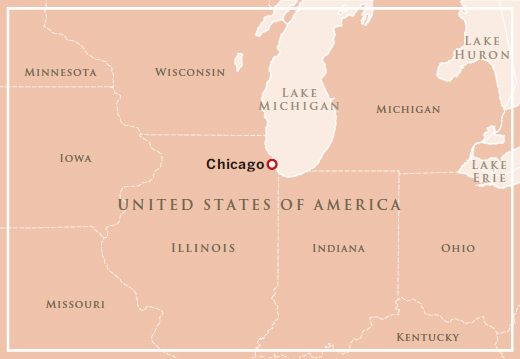
Chicago is an architectural mecca, bristling with buildings by the starchitects of today and home to the work and studios of past masters Louis Sullivan, Frank Lloyd Wright and Mies van der Rohe.
ESSENTIAL EXPERIENCES
* Immersing yourself in the Art Institute of Chicago’s renowned collections of Impressionist, post-Impressionist, American and contemporary art.
* Touring Frank Lloyd Wright’s home and studio – a fascinating place filled with the details that made the architect’s style distinctive.
* Catching a Cubs baseball game at home stadium Wrigley Field.
* Strolling the campus of the Illinois Institute of Technology’s College of Architecture in Bronzeville, studded with architectural gems by the likes of Rem Koolhaas, Helmut Jahn and Mies van der Rohe.
* Dining with a live blues act in a downtown club such as Rosa’s Lounge, or tapping your toe at a blues gig on revitalised Motor Row (South Michigan Ave).
The panorama from Chicago’s Millennium Park is of world-class architecture. Start with Frank Gehry’s Jay Pritzker Pavilion, with its twisting chrome segments rippling across the lawn, then turn to the right to be greeted by a glittering plane of blades: Renzo Piano’s Modern Wing of the Art Institute. Turn a little further and Adler & Sullivan’s 1889 Auditorium Building on South Michigan Ave is visible in the distance, as Anish Kapoor’s chrome sculpture Cloud Gate hovers like an alien blimp waiting to show you around the city that gave birth to the skyscraper, Chicago blues, house music, the Cubs and the Oprah Winfrey Show.
Chicago’s pioneering skyscraper architecture, dating from the end of the 19th century is known as the Chicago School, and architect Louis Sullivan was one of its most notable practitioners. Buildings by Sullivan reveal themselves as you stroll through downtown Chicago, with intricate explosions of ornamentation cast across monumental commercial buildings. Wander in any direction and you will come across a building or two by Mies van der Rohe, whose work is attributed to the Second Chicago School of the mid-20th century – minimalistic black towers of glass and steel that inspired modernist architecture across the globe. However, it’s not just the world’s finest skyscrapers that entice the archi-tourist to Chicago. Frank Lloyd Wright, one of the 20th century’s most famous architects and a pupil of Sullivan’s, has given the region a suite of prairie-style homes that are furnished with his own designs and open to the public.
The city’s appeal goes far beyond its buildings. From the 1940s to the 1970s Chicago was a hothouse for blues music, and then in the 1980s it became the crucible for house music, thanks to local radio stations, DJs and artists such as Larry Heard. Music is still at the heart of Chicago and no escape would be complete without a nocturnal adventure in sound.
LOCATION CHICAGO, ILLINOIS, USA | BEST TIME OF YEAR APRIL THROUGH OCTOBER | IDEAL TIME COMMITMENT A WEEKEND OR A WEEK | ESSENTIAL TIP DON’T MISS THE CHICAGO-STYLE BEEF SANDWICH (AND THE VIEW!) AT THE SIGNATURE LOUNGE ATOP THE JOHN HANCOCK CENTER | BUDGET $$ | PACK SOMETHING SMART TO WEAR OUT AT NIGHT: CHICAGOANS ARE VERY STYLISH

The Windy City, where the world’s first skyscraper was built.
BERTHOLD TRENKEL | GETTY IMAGES ©
AL CAPONE, KING OF CHICAGO
Al Capone, history’s most renowned mobster, may have been born in New York City, but it was after moving to Chicago that the young criminal made his mark. Exploiting the Prohibition Era of the 1920s to smuggle and bootleg alcohol, while also involved in other illegal ventures such as gambling and prostitution, Capone was able to lead the crime empire known as ‘the Outfit’ to great success, generating hundreds of millions of dollars in revenue annually. Capone’s support of charities made him a popular figure in Chicago, but his involvement in a mob-related shooting in 1929 tarnished his image. Capone was eventually convicted on tax offences and languished in Alcatraz prison from 1931 to 1939, before dying at home in 1947.

Blues legend Buddy Guy performing at his own venue on S Wabash Ave.
WIREIMAGE | CORBIS ©
GOT THOSE CHICAGO BLUES?
Blues music made it to Chicago from its southern origins of the Mississippi River Delta as a result of the Great Migration, when over one million African Americans moved north in search of work in the industrialised cities. The genre, inspired by African music and the highs and lows of daily life, flourished in Chicago and developed a regional dialect, characterised by an amplified harmonica and bass guitar, known as Chicago blues. The sound was centred on the Chess Records studio on South Michigan Ave. Now known as Motor Row, the strip of derelict car showrooms is being revitalised as an entertainment district, with a new L transit station, a craft brewery and live-music venues.
■ The Perfect Getaway
Arriving at the Art Institute of Chicago on South Michigan Ave with coffee in hand, a takeaway from Così a block north, you decide to leave the Impressionists for tomorrow and focus on the most unexpected permanent collection you could imagine in a city with the largest buildings in the Midwest. The exquisite Thorne Miniature Rooms, of which there are 68, are delicately crafted interiors at 1:12 scale, covering European design from the 13th century and American design from the 17th century through until the 1930s, when the models were made.
Before heading north to one of the steakhouses by Mariano Park for lunch, you duck across the road to the Chicago Architecture Foundation. Here you will find architecture enthusiasts who can sell you Gehry fridge magnets, organise tickets for the architecture cruise on the Chicago River and answer your every Chicago question. Grab a ticket for tomorrow’s bus trip to the neighbourhood where Frank Lloyd Wright lived and worked from 1889 to 1909; opt for the tour that takes in Wright’s own home and studio and includes a walking tour of Oak Park – a picturesque residential area where many prairie-style homes by Wright are on show – culminating in a tour of Wright’s charmingly detailed Unity Temple.
As light fades you jump on the L, the rail network elevated above the streets of Chicago’s inner Loop district, and travel on the red line north to Addison station; it’s only a short walk to Wrigley Field. While enjoying a Cubs baseball game you notice the scoreboard being operated by hand, the numbered plates carefully interchanged, and it becomes apparent the effort Chicagoans have invested, both today and in the many years past, in building their city and making it work.

Chicago’s Museum of Contemporary Art is a design delight.
FRANZ MARC FREI | GETTY IMAGES ©
■ Plan It
Chicago’s O’Hare International Airport is 30km from downtown Chicago; catch a cab, train or bus into the city centre. Consider a B&B or homestay (booked through websites such as www.airbnb.com) in one of Chicago’s elegant inner suburbs, such as Lakeview or Oak Park; good public transport allows you to expand your accommodation search beyond downtown. The Chicago Architecture Foundation is open daily until 6pm; the river cruise is offered in the warmer months. The Cubs play at Wrigley Field from April to September; book tickets well ahead.
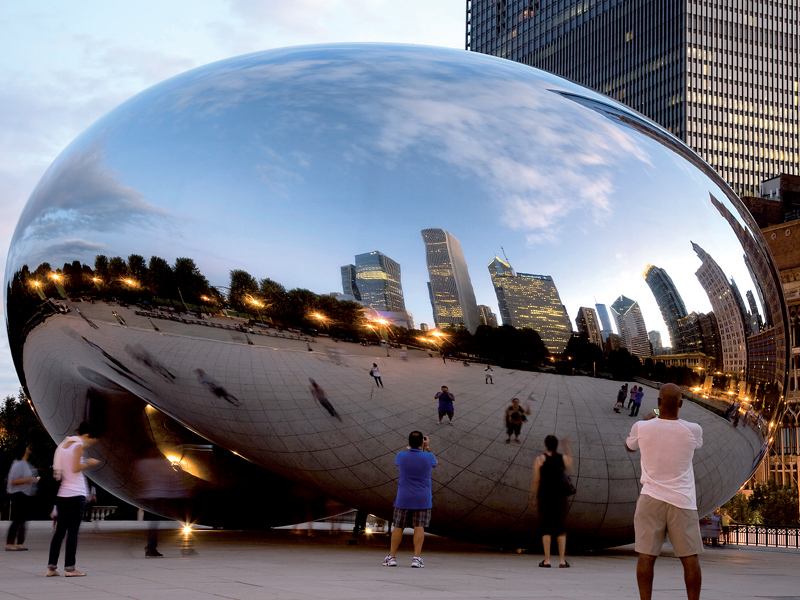
Right back at you: Anish Kapoor’s Cloud Gate sculpture.
CHARLES COOK | GETTY IMAGES ©
■ Detour
Mies van der Rohe’s seminal work, Farnsworth House, is considered one of modernism’s masterpieces. Built in 1951, the home is a perfect expression of Mies’ modernist ideal of architecture reduced to its straight-lined essence. Located near Plano, just over an hour’s drive west of Chicago, Farnsworth House can be reached by car or train, or on bus tours such as those run by the Chicago Architecture Foundation.
DECKCHAIR
* The Blues Brothers (1980) Seek out the film locations for this 1980s classic around the Loop district. The soundtrack is pure Chicago.
* Ferris Bueller’s Day Off (1986) This 1980s teen flick takes it to the streets of Chicago.
* High Fidelity (2000) One of the most popular movies set in the Windy City is actually based on a book set in London.
* High-Rise (JG Ballard) This dark fiction depicts a high-rise community in social free-fall.
* The Fountainhead (Ayn Rand) The story of one man’s modernist architectural vision pitched against the world.
* Grand Obsessions (Alastair McGregor) Follow the journey of two of Frank Lloyd Wright’s finest protégés, Walter Burley Griffin and Marion Mahony, in this epic biography.
FLAMENCO AND TAPAS IN ANDALUCÍA
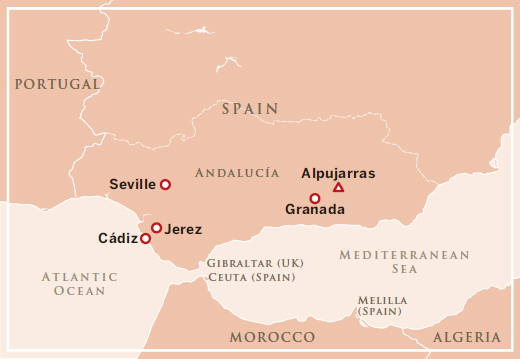
The triangle of land in western Andalucía between the cities of Seville, Jerez de la Frontera and Cádiz is one of the most culturally fertile regions in Spain, with multiple offerings to satisfy the ears, soul and stomach.
ESSENTIAL EXPERIENCES
* Taking a tour of a Jerez sherry bodega and educating your palate with some sherry tasting.
* Attending an Andalucian festival, such as Seville’s Feria de Abril – one of the most popular celebrations in Spain – or Jerez’ annual February flamenco festival.
* Bar-hopping in Santa Cruz, Seville’s medieval Jewish quarter, which hides countless packed-to-the-rafters tapas bars.
* Circumnavigating Cádiz’ romantic seawall on foot and visiting its forts and baroque cathedral.
* Finding peace in the Eden-like gardens of the Alcázar of Seville and inhaling the scent of orange blossom.
* Stumbling on a high-spirited flamenco show in a backstreet bar or – even better – a peña flamenca (private club).
It’s Friday night in Seville. In a dark flamenco club a crowd of revellers sticks toothpicks into a tray of tapas, raises a toast with glasses of crisp, dry sherry, and turns back towards the stage. The show, which had begun rather inauspiciously 30 minutes earlier, is reaching its climax, deflecting people’s attention away from plates of nutty cured ham and forcing them to lean forward in their chairs and listen. After a melancholic opening, the music has become quicker-paced and frenetic, the trio of dancer, singer and guitarist linking intuitively to create an explosive wall of sound and energy which they feed back to the hungry audience.
The drama builds with every chord, the dancer’s shoes driving hard against the floorboards and the gravel-voiced singer working into an operatic crescendo. Shouts of encouragement are offered from the onlookers. The guitarist glides through a fast, mesmerising solo. Fingers blur. Feet stomp. Somebody yells óle, and then suddenly the show is over – all that is left is a pleasant ringing in the ears and the notion that an epiphany has taken place.
When wine, food and music conspire, it can be a powerful experience. In Andalucía you can experience all three on the same night – and in the same bar too, if you’re lucky. Tapas were allegedly invented in Andalucía’s taverns several hundred years ago, after patrons began putting small slices of food over their wine glasses to keep flies out. Sherry’s origins are even older: the Phoenicians, Romans and Moors cultivated vineyards in the Jerez region, although it was the British penchant for fortified wine in the 19th century that financed the trade. Flamenco is virtually a synonym for Andalucía, a fusion of Byzantium hymns, Spanish folk songs, Jewish chants and the musical rhythms of Roma people. As with most home-grown inventions, nothing rivals experiencing them in the land of their genesis – in particular Andalucía’s charismatic capital, Seville.
LOCATION SEVILLE, SPAIN | BEST TIME OF YEAR MARCH THROUGH MAY | IDEAL TIME COMMITMENT FOUR OR FIVE DAYS | ESSENTIAL TIP ANDALUCIANS DINE AND GO OUT LATE (FROM 9PM); ADJUST YOUR TIME CLOCK TO ENSURE YOU’RE NOT MISSING OUT ON THE BEST NIGHTLIFE | BUDGET $$ | PACK COMFORTABLE WALKING SHOES, SUNSCREEN, CASUAL ‘GOING OUT’ CLOTHES

Flamenco in Seville isn’t just about dancing; there’s singing and guitar playing too.
ANDREA PISTOLESI | GETTY IMAGES ©
SHERRY IN JEREZ
Jerez de la Frontera, 75 minutes from Seville by bus or train, is Andalucía’s beating heart. The city is the first stop on the famed ‘sherry triangle’ and, despite counter-claims from Cádiz and Seville, the recognised cradle of flamenco. Sherry – a very Spanish drink concocted for very English tastes – can be quaffed in one of the city’s 20 illustrious sherry bodegas, or at a more down-to-earth backstreet bar with accompanying tapas. For flamenco, listen out in the historic bars of Calle Francos or enquire about venues and shows at the Centro Andaluz de Flamenco, a flamenco library and resource centre – the only one of its kind in Spain.

Drop into El Rinconcillo tapas bar, which dates from 1670.
WALTER BIBIKOW | CORBIS ©
TAPAS IN SEVILLE
Seville’s bars usually chalk up their tapa menus on a blackboard above the counter with dishes offered in three different sizes: bite-sized tapas, media raciones (half plates) or raciones (full plates). It is nearly always cheaper to eat standing at the bar than sitting down at a table. Aside from the standard Spanish fare, Seville has several local specialities, including huevos a la flamenca (eggs baked with chorizo and tomato sauce), espinacas con garbanzos (spinach with chickpeas), gazpacho (a cold tomato-based soup made with bread, garlic and olive oil) and jamón ibérico (a succulent cured ham from nearby Huelva province).
■ The Perfect Getaway
Get comfortable in a historic hotel in Seville’s Santa Cruz quarter, an ideal place from which to plan sorties. You could fill two mornings seeing Seville’s weightiest sights: its gothic cathedral and the Moorish Alcázar (royal palace complex); the monuments face each other across the Plaza de Triunfo. If you’re going tapas hunting in the evening, opt for a sit-down lunch around 2pm; restaurants full of swinging hams and dusty wine bottles are two-a-penny around the Plaza de la Alfalfa. Many Sevillanos enjoy a siesta between 3pm and 5pm. They wake up for a merienda at 5pm – a snack with coffee and cake.
Sitting pretty in medieval Santa Cruz is the Museo del Baile Flamenco, which provides an interesting prelude to a night of music. Seville’s nightlife rarely kicks off before 9pm when hungry music lovers head towards a tablao or bar. Tablaos are choreographed, if touristy, flamenco shows; Tablao El Arenal in the eponymous riverside district stages some of the most authentic performances.
For greater spontaneity cruise the city’s bars for tapas and live music. Some of the most fashionable places are in the Alameda de Hércules to the north. Here you can sample nouveau tapas, such as pork ribs in honey and rosemary glaze, or spicy Asian green chicken. More bars crowd the Santa Cruz quarter, home of famed flamenco venue La Carbonería, where the tapas are cheap and the music’s free. Triana is another nexus: the old Roma neighbourhood on the banks of the Guadalquivir river buzzes with alfresco action until late. Close by are the city’s more traditional flamenco venues, including Casa Anselma, a rambunctious bar where they don’t uncork the sherry and tune up their guitars until past midnight.

Very moreish: savoury jamón ibérico and a pale, dry sherry.
DIEGO LEZAMA | GETTY IMAGES ©
■ Plan It
Seville’s climate is pleasant year-round. The city is at its most ebullient during its festivals in March and April. Seville International Airport is 10km northeast of the centre; airlines link it with London and other European cities. Regular buses run to the city. Seville has hotels in all categories; places fill up (and treble their prices) for festivals. Book ahead! Santa Cruz and El Arenal are the most sought-after neighbourhoods, but beware of bag snatchers.

The Hall of the Ambassadors in Seville’s Alcázar.
SEBASTIANO SCATTOLIN/SIME | 4CORNERS
■ Detour
Sample Andalucía’s food, drink and flamenco further in Cádiz, one of Europe’s oldest cities, founded by Phoenicians 3000 years ago. Cádiz sits on a sinuous peninsula and is coveted for its fish restaurants, the best of which inhabit the gritty Viña quarter. Its flamenco tradition emanates from the grizzled Santa María neighbourhood, where the city’s signature songs, called alegrías, can be heard at Peña Flamenca La Perla, perched beside the wave-lashed seawall. Cádiz also has several historic forts and a stash of raffish seafaring bars to explore.
DECKCHAIR
* Duende: A Journey in Search of Flamenco (Jason Webster) A British-American writer becomes embroiled in the intriguing, traditionally closed world of flamenco.
* Driving over Lemons (Chris Stewart) Insightful and humorous take on Andalucía through the eyes of a British expat.
* Collected Poems: A Bilingual Edition (Federico García Lorca) Spain’s ultimate poet: evocative, provocative and Andalucian to his core.
* The Ornament of the World (María Rosa Menocal) The History of Moorish Al-Andalus (711–1492) in one readable volume.
* Dining Secrets of Andalucía (Jon Clarke) Definitive dining guide to the region.
* Camarón (2005) A biopic of Camarón de la Isla, the greatest modern flamenco singer.
A CULTURE SPREE IN BERLIN
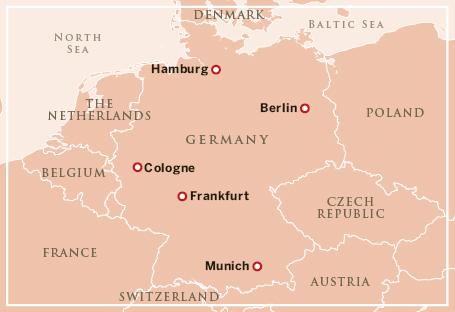
When Berlin became the capital of reunified Germany in 1999, the city was to be a corporate showcase of national prestige. But Berlin chose the arts over finance. Edgy, educated and elegiac, it’s now a cultural honey pot, with many of the world’s standout museums.
ESSENTIAL EXPERIENCES
* Walking through six millennia of art history at Museumsinsel (Museum Island).
* Strolling down Unter den Linden – one of Europe’s richest historical boulevards.
* Climbing wartime history at the Brandenburg Gate and the Reichstag – Berlin’s triumphal gate and parliament building.
* Remembering recent history at the Jüdisches Museum (Jewish Museum): a Daniel Libeskind–designed icon that changed the face of museums.
* Gazing at the masters at the Gemäldegalerie, one of the world’s best art collections in the world, featuring Rembrandt, Titian, Goya, Botticelli, Holbein, Rubens, Vermeer…
* Chilling in the Tiergarten, an 18th-century hunting-ground-turned-park offering respite from a sometimes bleak city.
* Strolling down west Berlin’s great shopping strip, the Kurfürstendamm, or Ku’damm.
As fire rendered the Reichstag a smouldering ruin in 1933, it was a sad omen of the devastation to come. But now the building is Berlin’s gleaming monument to reunification, topped by a glass dome courtesy of Sir Norman Foster. With a 360-degree view over Berlin’s skyline, the home of the Bundestag (Germany’s parliament) is the place to come and survey the revitalised German capital.
Look out from the dome, and on one side there’s the Hamburger Bahnhof, a contemporary art museum in an old railway station. To the other is Unter den Linden, Berlin’s historic artery, leading down to the Unesco-listed Museumsinsel (Museum Island). Gaze across the Tiergarten, Berlin’s graceful park, to spot the Kulturforum arts complex. In Berlin, culture dominates. The city hosts some 180 museums, three opera houses, 150 theatres, 130 cinemas, eight symphony orchestras and upwards of 1500 events a day. You can spend months here and not exhaust the possibilities – one of the reasons why the city is a great draw to contemporary artists, turning the city into a creative global powerhouse.
There are reasons why Berlin is so rich in culture. Partly it’s because of the showboating following reunification, partly because architect-planner Karl Friedrich Schinkel wanted to turn it into a worthy capital of Prussia in the early 19th century – and partly because Berlin was divided from 1961 to 1989, giving it two of everything. But Berlin itself is a living museum. Walk the streets and you’ll feel a sense of the great 20th-century battles, some of which have left bullet holes. There’s plenty of public art and some of the world’s most concentrated and rewarding cultural zones anywhere – most notably Museumsinsel, sitting like an artistic fortress in the Spree river. After 1990, Berlin had expected to be the commercial centre of Europe. Instead, it became the cultural centre – and mammon’s loss has been the art-loving traveller’s gain.
LOCATION GERMANY | BEST TIME OF YEAR MUSEUMS ARE OPEN YEAR-ROUND BUT IT’S BITTERLY COLD IN WINTER; SUMMERS ARE LOVELY | IDEAL TIME COMMITMENT THREE DAYS FOR THE HIGHLIGHTS | ESSENTIAL TIP PURCHASE A WELCOME CARD FOR SAVINGS ON TRAVEL AND MUSEUMS | BUDGET $$ | PACK COMFORTABLE SHOES; YOU’LL DO A LOT OF HIKING IN SPREAD-OUT BERLIN

The Bode-Museum, at the head of Museum Island, houses works from the Middle Ages to the 18th century.
MATTHIAS MAKARINUS | GETTY IMAGES ©
CULTURE BITES
Done Berlin’s grand collections? Then try some of its smaller museums. The Brücke Museum in the suburb of Dahlem is a gem, devoted to the early 20th-century artist’s group of the same name. The Bauhaus-Archiv in Tiergarten will please fans of the influential 20th-century design school. Don’t forget the more absurd offerings: the Currywurst (curried sausage) museum, the football museum and the hilarious DDR Museum, a bittersweet look at life in the former East Germany. And old punks won’t want to miss the Ramones museum in East Berlin, a fan’s tribute to the ‘Fast Four’.

Dressed to impress: backstage at a cabaret in Mitte.
HANNIBAL HANSCHKE | CORBIS ©
OH, CABARET!
Given that many of Berlin’s tourists have seen the musical Cabaret, Berlin has a reputation as a place of theatre and spectacle. But it took until 2009 to re-establish a theatre zone in the city’s central district. Now, in the area between Friedrichstrasse, Unter den Linden and Hackescher Markt, four venues – Quatsch Comedy Club, Distel Cabaret Theatre, Friedrichstadt-Palast and the Chamäleon theatre – come together to form the nucleus of a new theatre district. The area is Berlin’s own theatreland, in one of Mitte’s most atmospheric neighbourhoods. Very Sally Bowles.
■ The Perfect Getaway
Start at street level – Berlin rewards the flâneur. At the Holocaust Memorial, by the Reichstag, you’ll see 2711 grey stelae – great funereal slabs of concrete by New York architect Peter Eisenman. Then stroll via the Brandenburg Gate down Unter den Linden to Bebelplatz, where the Nazis burned books in 1933, and through a window in the cobbles view the underground empty library installation by Israeli artist Micha Ullman. From here it’s a brisk hike to the Topographie des Terrors, an open-air exhibition atop the bulldozed Gestapo’s Berlin headquarters, next to one of the few remaining parts of the Berlin Wall.
Further down Friedrichstrasse, the Jüdisches Museum (Jewish Museum) is as famous for its Daniel Libeskind design as for its content, and culminates in the Holocaust Tower: empty space surrounded by dramatic shards of concrete. Nearby, in a glass depot, is the Berlinische Galerie. With artists like Otto Dix and George Grosz, it’s a heady evocation of Berlin’s 1920s and ’30s – the decadent Weimar years that are so captivating.
You’ll need a fortifying lunch: try the bohemian areas of Kreuzberg and Hackescher Markt in Mitte (the old town). Back on Unter den Linden, go to the Spree river to find Museumsinsel: this ensemble of five treasure houses is the city’s cultural highlight, with the Altes Museum (Old Museum) by Karl Friedrich Schinkel at its heart, augmented by the Neues Museum (New Museum), Alte Nationalgalerie (Old National Gallery), Bodemuseum and Pergamonmuseum – including the stupendous Pergamonaltar, taken in its entirety from Asia Minor. Here, you can run through 6000 years of world civilisation. Stupendous, but true.

MASSIMO BORCH | CORBIS ©

The grand and the gritty: the Bode-Museum and a street cafe in the neighbourhood of Mitte, Berlin’s theatreland.
MAREMAGNUM | GETTY IMAGES ©
■ Plan It
Most visitors arrive via Berlin’s two international airports. Use the U-Bahn and S-Bahn underground trains to get around. Arts events happen year-round; standout festivals include the new Berlin Art Week and the Berlin International Film Festival. Berlin’s Long Night of Museums takes place twice a year; venues open their doors until 2am.
■ Detour
Half an hour outside Berlin is Potsdam, a town renowned for its role in the post–World War II carve-up. It remains the only East German town to have experienced population growth after reunification. In the 18th-century Dutch quarter, look out for quaint shops with green shutters, and stroll around the lake – during the Cold War, these waters were patrolled by gunboats – then go to the Glienicke Bridge, the old rendezvous for spy-swaps. Cecilienhof, the mock-English villa where Churchill, Stalin and Truman met in August 1945 to finalise Europe’s post-war settlement, is now a hotel with plentiful memorabilia.
DECKCHAIR
* Goodbye to Berlin (Christopher Isherwood) The book that gave rise to the film Cabaret, and a brilliant evocation of Berlin in the pulsating interwar years.
* Berlin Alexanderplatz (Alfred Döblin) Protagonist Franz Biberkopf ducks and dives on the streets of Weimar-era Berlin. Also a film.
* The Lives of Others (2006) The vicious atmosphere of Stasi-run East Berlin is nailed by director Florian Henckel von Donnersmarck.
* The Innocent (Ian McEwan) Via hero Leonard Markham, McEwan evokes the Berlin of 1955.
* Stasiland (Anna Funder) Funder’s breakthrough book is a great portrait of East Germany’s secret police.
* Funeral in Berlin (Len Deighton) Great Cold War potboiler that gave rise to a film, starring Michael Caine as Harry Palmer.
SALSA MAGIC IN SANTIAGO DE CUBA
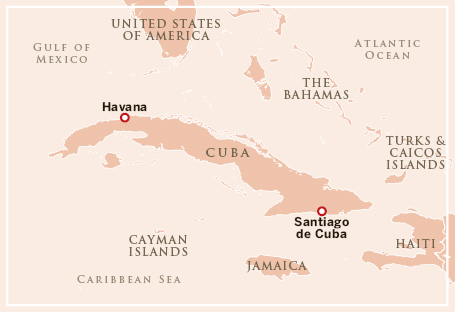
Get your hips moving on a Cuban dance floor if you really want to find out what makes this astonishing island tick. Learn to dance and you’re guaranteed to discover more about the unique cultural mix that underpins life in the coolest communist outpost.
ESSENTIAL EXPERIENCES
* Discovering the rhythms and instruments that go into making son, one of Latin America’s most influential forms of music.
* Sitting in on a band’s practise session or discovering musicians honing their skills in bars around town.
* Learning to dance to traditional Cuban son and testing your skills for real on the dance floors of Santiago de Cuba.
* Photographing classic American cars with Santiago de Cuba – Cuba’s ‘most Caribbean city’ so they say – as your backdrop.
* Learning Spanish in formal language lessons, then honing your new language skills in dance lessons.
* Sampling Cuba’s famous rum cocktails and getting the low-down on the history of the hard stuff at the Museo del Ron.
You can sense Cuba’s musical undercurrent from the moment your plane touches down. Baggage handlers throw suitcases around with a rhythmic flourish and customs officials shimmy in their booths to the tinny splutterings of a wall-mounted loudspeaker. Music is everywhere, and even when it’s not playing, most Cuban hips seem to be twitching to a built-in metronome.
To understand the island’s people and rich mix of cultures, you really need to step onto a Cuban dance floor. Under the dishevelled colonial arches of a dance school in Santiago de Cuba, you’ll take your first steps into the world of salsa, guided by a trained dancer. With one-to-one tuition, moves are built up slowly over the course of a week until you’re performing increasingly complex steps, learning to spin with your partner in beguiling grace. There’s a dance-school work ethic as once again you ‘take it from the top’ to perfect each section, but the pay-off comes quickly. Within a few days, early nerves start to give way to a noticeably Latin swagger in the hips and a seductive shimmy in the shoulders. And then comes the cry of Salsa libre! from the instructor, the signal that it’s time to improvise your moves for the next couple of bars. For some that means a creative and fluid interlude, for others a mess of limbs and helpless laughter.
Broad smiles and tired feet spill out onto the street at the end of a day’s class, but your musical adventure continues. Wander the streets and live music is all around you, from the city’s world-famous venue, Casa de la Trova, to a host of smaller local bars, giving you plenty of opportunity to finesse your moves. By the final night, while you certainly won’t be the hottest dancer in town, you will be able to hold your own on a Cuban dance floor. You’ll have a feel for the blend of Spanish canción and African rhythms that underpin Cuban son music, and you’ll have had an experience that has taken you to the very heart of Cuban life.
LOCATION SANTIAGO DE CUBA, CUBA | BEST TIME OF YEAR SUMMER (JUNE TO AUGUST) IS FESTIVAL SEASON; COOLER WEATHER IN SPRING OR AUTUMN IS BETTER FOR DANCE CLASSES | IDEAL TIME COMMITMENT ONE TO TWO WEEKS | ESSENTIAL TIP LEARN SOME SPANISH TO GET THE MOST FROM YOUR TRIP | BUDGET $$ | PACK DANCING SHOES

A guitar and double bass are the foundation of the local son sound.
BENJAMIN RONDEL | GETTY IMAGES ©
THE CUBAN BEAT
Cuban son originated in the eastern part of Cuba and is a happy combination of forceful African rhythms and poetic Spanish melody. The ethnomusicologist Fernando Ortiz called it ‘a love affair between African drum and Spanish guitar’. The traditional set-up includes six musicians playing guitar, tres (a Cuban guitar with three sets of double strings), bass, bongos, claves and maracas. In the 1920s many bands added trumpet to the mix. Cuban son is probably the forerunner of salsa and one of the most influential forms of music in Latin America. You’ll find a Casa de la Trova in most large towns – it’s the best place to hear it being played live.

Dancing girl: learn the steps at salsa school.
BRUNO MORANDI | GETTY IMAGES ©
SANTERÍA RELIGIOUS BELIEFS
A mixture of African, Catholic and Native American traditions, Santería is a syncretic religion that focuses on building relationships between humans and powerful mortal spirits called orishas. Followers believe that if they carry out the right ritual, these spirits will help them fulfil their destiny. But these powerful spirits also rely on their followers. They need to be worshipped and rely on offerings of food and even animal sacrifice if they are to continue to exist. Many orishas are associated with Catholic saints, such as St Barbara, known as Changó, and St Lazarus, known as Babalú-Ayé. There is no holy text or equivalent of the Bible – the beliefs are instead passed on by word of mouth.
■ The Perfect Getaway
Learning to dance in Cuba isn’t just about perfecting salsa moves or discovering the more subtle world of Cuban son. This is an escape for those who want to connect with the real Cuba, and experience as much of the island as possible. And there’s no better way to do that than by staying with a Cuban family.
You’ll instantly see the stark contrasts between the classic American cars and colonial architecture outside and the austere communist propaganda that forms prime-time TV. You’ll see the gulf between younger Cubans, many with their sights set on Florida (a mere 150km away) and an older generation who love Fidel and blame the US trade sanctions for all of Cuba’s problems. You’ll be introduced to a vibrant and sociable extended family who wander in and out of each other’s homes, but you’ll also develop a nagging awareness of communist party members who lurk in unexpected places, keeping an eye on the island’s ideology.
Cubans love to have fun and they want you to see that side of their country. Make a few friends and you’ll soon find yourself being taken into bars to meet musicians or into houses to see bands practise. You’ll discover the tres (a guitar that takes three sets of double strings), an instrument that gives Cuban music a distinctive sound, and you might even be handed a pair of claves (wooden percussion instruments) and invited to join in. Hang around for a glass of rum or two and you’ll notice the African influence that delivers a more rhythmic, vibrant form of music in Santiago de Cuba than other parts of the island. It’s also the source of Santería, the local religion that was brought to the island by African slaves and merged with Catholic and Native American traditions.

Pay a visit to the bar La Bodeguita del Medio in Havana.
IMAGESTATE | ALAMY ©
■ Plan It
Antonio Maceo Airport is 7km south of Santiago de Cuba; international flights arrive here from Paris-Orly, Madrid, Milan and Rome on Cubana airlines and from Toronto on Air Transat. There are direct flights from the Cuban capital, Havana, every day. Local families rent rooms – look for the distinctive blue insignia on the door marked ‘Arrendador Divisa’. A number of Cuban dance and language specialists can organise visas, rooms and lessons, such as Caledonia Languages.
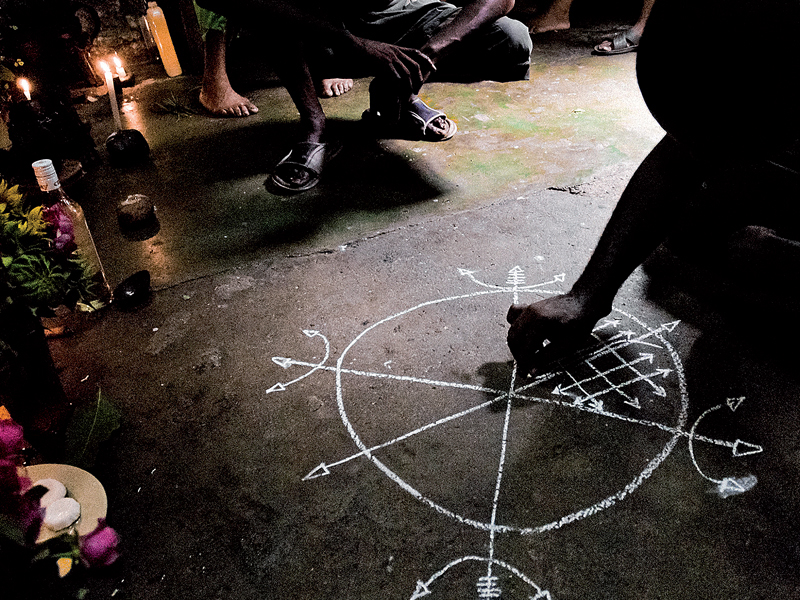
The rites of Afro-Cuban religions are performed at temples in Santiago de Cuba.
JAN SOCHOR | CORBIS ©
■ Detour
Santiago de Cuba province is home to Cuba’s highest mountain, Pico Turquino (1972m). It sits at the heart of the Sierra Maestra and was the stronghold of Fidel Castro and Che Guevara’s rebel forces pre-1959. Its cloud forest teems with wildlife, including the world’s smallest toad and some astonishing birds. The hike up Pico Turquino starts from Las Cuevas, 130km west of Santiago de Cuba. Hit the summit and you’ll find a bust of José Martí, hero of the second independence war.
DECKCHAIR
* Buena Vista Social Club (1999) Documents a group of ageing musicians who take traditional Cuban music to the world.
* Dance with Me (1998) Contrasts Cuban dancing styles in the tale of a Cuban émigré who opens another world for a ballroom dancer.
* Our Man in Havana (Graham Greene) The tale of a British vacuum cleaner salesman who enlists in the British secret service and sends in bogus reports that mysteriously start to come true.
* Ay, Cuba! (Andrei Codrescu) Romanian writer Codrescu visits the ‘laboratory of pre-post-communism’ to compare the island with his homeland in 1989.
* Trading with the Enemy: A Yankee Travels Through Castro’s Cuba (Tom Miller) Cuban lore gleaned from an eight-month tour of the island.
* The Reader’s Companion to Cuba (edited by Alan Ryan) Collected works of writing on Cuba.
AN IMPRESSION OF MONET’S NORMANDY

Inspirational – that’s Normandy. Its cliffs, cathedrals, glittering seas and gorgeous gardens have moved many a master to put brush to canvas. Spend a week here and you can put yourself properly in their pictures.
ESSENTIAL EXPERIENCES
* Visiting the inspirational, lily-laden gardens of Monet’s house at Giverny.
* Attempting to paint your own picture of Rouen Cathedral ‘à la Claude’; workshops are available.
* Yomping up the coast at Étretat to admire the sea views, chalk cliffs and rock arches.
* Strolling along the Impressionists Promenade at Sainte-Adresse; replica artworks have been placed in the exact spots on which the originals were painted.
* Watching the sun rise over the port of Le Havre, where Monet painted Impression, Soleil Levant.
* Sleeping in Room 22 of Honfleur’s fancy Hôtel La Ferme Saint-Siméon, which offers an authentic Monet view.
It’s like walking through a painting. The weeping fronds of willow trees sweep like long brushstrokes; pink-white waterlilies daub their liquid canvas; trailing purple wisteria forms a flowery frame. You stand on a little arching bridge and squint, causing the colours to swirl, edges to soften and shapes to blur into a vision that is discernibly a garden, yes, but one in rather lovely low-definition.
Welcome to the world of Claude Monet.
Monet was a founder of the French Impressionist movement – it was one of his paintings, an ‘impression’ of a sunrise, that gave the avant-garde group its name. Born in Paris in 1840, for a time he lived and worked there, gathering with fellow artists Renoir, Manet, Sisley et al at Café Guerbois to carouse and debate. But it was among his glorious gardens at Giverny, Normandy – where he made his home from 1883 until his death in 1926 – that Monet created some of his most famous works. He once said, ‘Besides gardening and painting I don’t know anything’. But about those two, he knew a great deal. His Giverny home, a tidy pink house with bright-green shutters, is merely a foil for what surrounds it – trellised walkways, rampant flowerbeds, fruit trees and pretty ponds arranged in disarranged fashion: tended, but not regimented or constrained. It was here that Monet, despite suffering worsening sight problems from 1908, painted his many studies of water lilies. His garden, he said, was his ‘greatest expense’ but also his greatest thrill: ‘I am in raptures’.
However, Giverny was not the only spot in Normandy to stir Monet and his Impressionist friends. Riddled by the Seine, this seaboard province of fertile farmland, Gothic and Romanesque towns and, more latterly, moving war cemeteries, is dotted with sites that inspired their works. A week spent exploring – from gardens to riverbank to coast – is to dip into the palette of these master painters and see behind the canvas.
LOCATION NORTHWEST FRANCE | BEST TIME OF YEAR APRIL TO OCTOBER | IDEAL TIME COMMITMENT SEVEN DAYS | ESSENTIAL TIP VISIT GIVERNY ON A WEEKDAY MORNING TO AVOID THE CROWDS | BUDGET $$ | PACK SKETCHBOOK, PENCILS

The garden of Monet’s Giverny house remains much as he depicted it.
DEREK HARRIS | ALAMY ©
DOING IMPRESSIONS
Impressionism hasn’t always been popular. The term, coined in 1874 to describe a group of unconventional Parisian painters including Monet, Cézanne, Renoir and Pissarro, was meant as an insult. Traditionalists just didn’t get their style, which was to portray a general visual effect rather than details. They used short, rapid, often visible brushstrokes in bright, intermingling colours to convey the sense of a scene, rather than its absolute reality. They painted landscapes and urban tableaux, usually en plein air (outdoors) rather than in studios, to better capture changing light and spontaneity. The results? Fresh, free and – eventually – beloved worldwide.
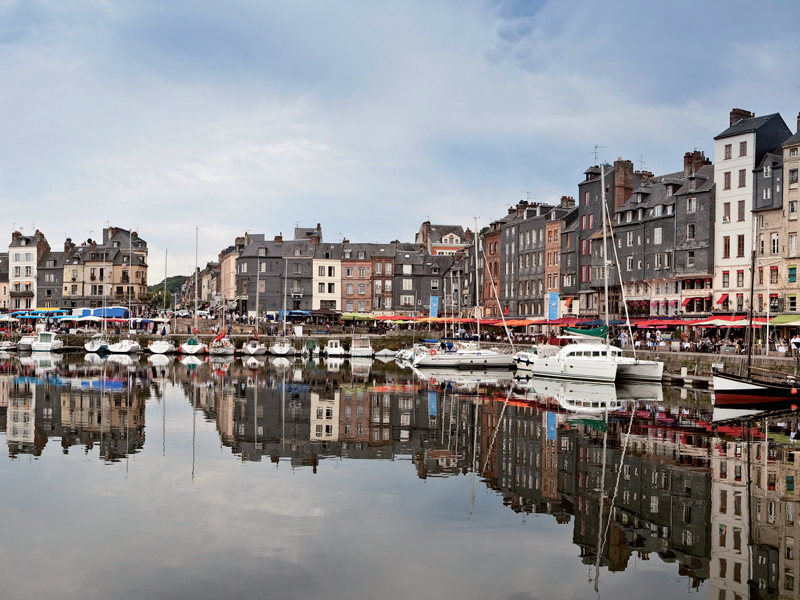
Honfleur’s harbour has been captured on canvas by amateur and world-famous artists.
NICK SERVIAN | GETTY IMAGES ©
THE ART OF EATING
The artist’s smock could have been invented for Normandy – to shroud its Impressionists and to allow for the inevitable bloating following a Normandaise meal. The rich pastures of the region are renowned for their dairy produce: milk and butter are ladled into dishes with abandon (look for meat cooked vallée d’Auge style) while local cheeses include Pont L’Évêque, whiffy Livarot and the world-famous creamy Camembert. Traditional drinks make the most of the orchards’ spoils – expect pear and apple ciders and fruit brandies, most notably Calvados, which is often drunk in small amounts between courses of a lengthy meal, to create un trou (hole) Normande.
■ The Perfect Getaway
Start in the art lover’s paradise of Paris. The capital has nabbed all Monet’s best works for the Orangerie and Musée d’Orsay. (And it’s always nice to visit Paris.)
The Normandy trail proper starts on the next day, with Giverny. Visit in April or October to avoid the crowds, or May to June to see the rhododendrons and wisteria in flower. Nearby, Giverny’s Musée des Impressionismes gives some background; it also runs painting workshops. Then trace the Seine northwest – via the castle at Les Andelys, which inspired many masterpieces – to Rouen, one of France’s oldest cities. Its medieval centre is dominated by a Gothic cathedral, which Monet painted more than 30 times. On some summer evenings, Impressionist works are projected onto the facade. Also, don’t miss Rouen’s Musée des Beaux-Arts to see some of the paintings Paris didn’t pinch.
Spend days five and six tracing the Alabaster Coast between Dieppe and Le Havre. Dieppe moved many painters: Turner loved it, and the Saint-Jacques church contains a series by Pissarro. But it was Étretat, further west, that Monet loved; he painted the rock arches here many times. Stop at pretty Sainte-Adresse, where Monet created his first Impressionist piece, before hitting Le Havre; its fine light attracted many artists and the town’s museum contains the second-largest collection of Impressionist works in France. Purists should wake early for sunrise: this is where Monet painted Impression, Soleil Levant, the work that lent the movement its name.
Save day seven for Honfleur; painters flock here to capture its harbour full of boats a-bobbing. Monet and his chums used to climb the Côte de Grâce hill for lunch at the tavern. That simple inn is now Hôtel La Ferme Saint-Siméon; spend your last night here, in room 22 – Monet’s favourite.

For a taste of Normandy, steam mussels in cider rather than wine.
GREG ELMS | GETTY IMAGES ©
■ Plan It
Le Havre, Dieppe and Cherbourg are Normandy’s key ferry ports. To reach Giverny from Paris, take the Rouen-bound train from Gare Saint-Lazare and disembark at Vernon station. Giverny is 5km from Vernon; shuttlebuses leave the station just after trains arrive. Monet’s house and gardens are open daily April to October, 9.30am to 6pm; avoid queues by booking tickets online. Normandy Tourism is developing an Impressionists Cycle Trail, which will connect key sites; download a guide from the Normandy tourism board website.
■ Detour
In counterpoint to Normandy’s beautiful art is its bloody horror. On 6 June 1944 thousands of Allied troops landed on an 80km stretch of coast north of Caen. The sandy beaches are still known by their D-Day codenames: Utah, Omaha, Gold, Juno and Sword. Today there’s little evidence of the landings, though German bunkers are still visible in Omaha’s cliffs and parts of a Mulberry harbour remain at Arromanches. There is a Memorial Museum of Peace in Caen but most moving are the war cemeteries that dot the countryside. Every nation has its own graveyards; with row upon row of headstones, each is a sobering but essential sight.
DECKCHAIR
* The Private Lives Of The Impressionists (Sue Roe) A look at the dreams, disputes, losses and loves of the avant-garde artists.
* Monet at Giverny (Caroline Holmes) A visual exploration of the artist’s glorious gardens.
* Katie and the Waterlily Pond: A Magical Journey Through Five Monet Masterpieces (James Mayhew) Delightful book following the heroine’s hop into a canvas – great for enthusing children about art.
* Monet: Ready to Paint the Masters (Noel Gregory) How-to guide on reproducing Monet paintings.
* The Impressionists (2006) BBC miniseries about Monet, Degas, Renoir, Cézanne and Manet, based on archive letters and records, and partly shot in Normandy.
* Madame Bovary (Gustave Flaubert) The author’s home town of Rouen provides the backdrop to this 19th-century classic.
INTO THE HEART OF THE MAYAN WORLD

There’s more to southeast Mexico than the megaresorts of Cancún. The Yucatán offers rich Mayan history, colourful colonial cities, charming hacienda hotels, and plenty of opportunities to swim in cenotes, eat barbecued pork and chill out in hammocks.
ESSENTIAL EXPERIENCES
* Cooling off in a cenote (limestone sinkhole) after a hot day of sightseeing.
* Eating cochinita pibil, the signature dish of the region – pork marinated in acidic juices, wrapped in banana leaves and slow-roasted, traditionally in an underground fire pit.
* Taking an afternoon siesta in a hammock, a balmy breeze on your face.
* Exploring Mayan culture at the Gran Museo del Mundo Maya in Mérida, a new museum inaugurated in 2012 – signifying a new beginning, not the end of the world.
* Viewing the top-notch collection of Mexican folk art at Casa de los Venados in Valladolid.
* Dining at Hartwood in Tulum, which not only serves great grilled fish and local meat, but perfectly encapsulates Tulum’s eco-chic vibe.
OK, so the whole Mayan ‘end of the world’ thing didn’t exactly pan out in 2012. (Never mind that that wasn’t what their calendar predicted anyway.) But the Mayans, whose civilisation flourished between AD 250 and 900, knew a heck of a lot about astronomy, architecture, mathematics and civilisation-building – as sites like Chichén Itzá and Uxmal clearly attest – and their legacy in Mexico’s most tropical state makes that corner of the country a compelling destination.
On top of those Mayan roots – offshoots of which are still thriving today – this region has a rich Spanish-colonial heritage. During the 19th century it was the home of plantation owners who struck it rich in the henequen trade (a plant in the agave family which was used for twine and rope). The cargo ships used to transport henequen to Europe came to Mexico laden with stone, bricks and tiles, which were used to build the plantation owners’ French-style city homes in Mérida, as well as the countryside plantations themselves. When the henequen boom busted, many of these opulent haciendas were left to rot for decades. Ceilings collapsed, paint chipped and trees grew through the walls, lending them a glamorous decay. By the 1990s that crumbling grandeur began appealing to expats and wealthy Mexico City dwellers, who bought houses in Mérida and estates in the Yucatán, fixing them up and turning them into boutique hotels.
A vacation here is culturally edifying – exploring one of the most advanced pre-Columbian civilisations – and jaw-dropping: words fail when confronted with the massiveness of Chichén Itzá and the intricate detail of Uxmal. It’s also relaxing, stepping out of time in a way – taking a room in a hacienda hotel, strolling the jungly grounds, imagining yourself as the owner of a 19th-century manor. And taking siestas, of course, usually in a hammock. Cap it off with a few days on the bohemian beaches of Tulum and combine history with more hedonism.
LOCATION YUCATÁN, MEXICO | BEST TIME OF YEAR OCTOBER TO MARCH, THOUGH OCTOBER STILL CARRIES A HURRICANE RISK | IDEAL TIME COMMITMENT ONE WEEK | ESSENTIAL TIP ONLY TOURISTS WEAR SHORTS, T-SHIRTS AND FLIP-FLOPS; LOCALS MAKE MORE OF AN EFFORT | BUDGET $$ | PACK A PASHMINA: THERE’S LOTS OF ALFRESCO DINING AND WINTER EVENINGS CAN BE COOL

There are thousands of cenotes in which to swim in the Yucatán.
OCEAN | CORBIS ©
SWIMMING IN CENOTES
Among the Yucatán’s most distinctive features are cenotes, water-filled sinkholes that were formed when the limestone cratered in. Often in caves or vine-draped caverns, with craggy stalactites and small openings to the sky, an estimated 6000 of them dot the state. They were the only source of fresh water in ancient times, and sacred in Mayan cosmology because they were believed to be the entrance to the underworld. (They’re also reputed to be the site of sacrificial offerings.) Now they’re popular with visitors to the area, who make them the last stop on a day tour for a refreshing swim.

The Magician’s Pyramid at Uxmal, a Mayan site.
PAUL HARRIS | AWL-IMAGES ©
MAYAN HEALING PRACTICES
The Yucatán is rich with traditional wellness experiences. The yoga mecca of Tulum offers plenty of places for visitors to try temazcal ceremonies (chanting and offering prayers in a sweat lodge) for spiritual and physical purification. Throughout the state there are shamans who have abilities to bridge the natural and spirit worlds, bring rain and, most important for tourists, heal individuals. At Hacienda Xcanatun, guests can have massages and energy work done by lead spa therapist Carolina Martinez, the granddaughter of a famous Mayan shaman who recently attained shaman status herself.
■ The Perfect Getaway
An exploration should start in Mérida, the heart of the region. The Yucatán is Mexico’s most educated and culturally rich state, and it shows in the city’s grand architecture. Along with a growing handful of stylish hotels, Mérida has excellent restaurants, bars and culture, with musical performances every night and a Sunday event that turns the central plaza into a market, musical stage and party.
Stay at Hacienda Xcanatun: it’s a short drive from the city centre, but isolated enough to be peaceful. The 18 suites have handmade furniture, dramatic bath-tubs (some carved from massive boulders) and – blissfully – no TVs. The sense of place is strong, with a Yucatecan chef in the kitchen and a Mayan shaman in the spa (see left). The hacienda is a superb base for excursions to archaeological sites like Chichén Itzá, a Unesco World Heritage Site, and the less-crowded Uxmal, where the central Temple of the Magician is covered in ornamentation and monster masks. Hacienda Xcanatun can set guests up with guide extraordinaire Carlos Sosa, who guides Smithsonian Institution trips.
From there, head southeast to Tulum, where Mayan culture still exists but is overlaid with stylishness now that New York fashionistas flock there and ‘pop-up’ hotels like the Papaya Playa Project have sprouted. For all that, it’s still low-key, with a fabulous beach and appealing Mayan ruins.
Mérida to Tulum is an easy drive, but a stop midway in Valladolid is rewarding. The city is strongly Mayan and distinctly Spanish (evident in the architecture), and newly cosmopolitan. A recent influx of expat creative types has led some to call Valladolid the next Tulum. Go now, while it’s still ‘next’.
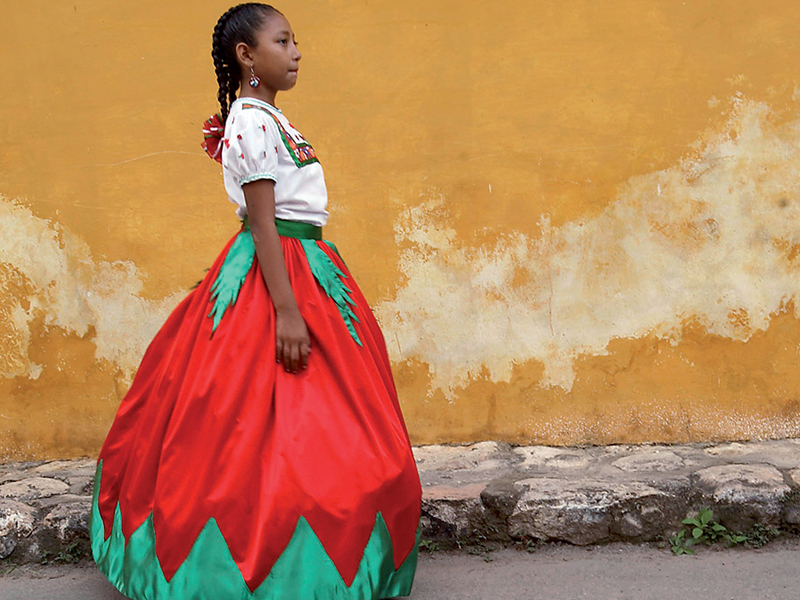
Traditional dress in Izamal, the ‘Yellow City’, close to Mérida.
JANET JARMAN | CORBIS ©
■ Plan It
Most international flights to Mérida are via Mexico City or Cancún. Hacienda Xcanatun is an hour from Mérida’s airport and can arrange transfers, and excursions into the city and to Mayan sites. From Mérida it’s a three-hour drive to Tulum, then a further two hours up to Cancún, from where you can fly out. Tour operators like Catherwood Travels can organise transfers and drivers for day excursions, but they aren’t necessary for everyone. The Yucatán is the safest state in Mexico and its roads are good, so renting a car is an option.

Colonial gem: the Governor’s Palace in Mérida, the Yucatán’s state capital.
JEAN-PIERRE LESCOURRET | GETTY IMAGES ©
■ Detour
The famous scuba-diving destination, Cozumel offers a more typical Mexican beach holiday, with full-service resorts and less guilt about lying on the beach, margarita in hand, instead of learning about ancient cosmology. But the island, off the coast near Playa del Carmen, is about the underwater action. Divers come to explore the Mesoamerican reef – the western hemisphere’s largest and home to more than 250 species of fish, turtles, manta rays and more.
DECKCHAIR
* Incidents of Travel in Yucatán (John Lloyd Stephens and Frederick Catherwood) A real-life adventure, originally published in 1841.
* A Field Guide to Mexican Birds: Mexico, Guatemala, Belize, El Salvador (Peterson Field Guides) A primer on the native birdlife.
* A Forest of Kings: The Untold Story of the Ancient Maya (David Freidel and Linda Schele) A recent interpretation of Mayan hieroglyphics.
* Interpreting the Ancient Maya (Tatiana Proskouriakoff) An overview from a mid-20th-century scholar, who produces a vision of ancient Mayan sites at the height of their grandeur.
* Tales from the Yucatán Jungle: Life in a Mayan Village (Kristine Ellingson) A memoir by an American who finds a home near Uxmal.
* Outside the Hacienda Walls (Allan Meyers) A look at the heyday and demise of the henequen plantation era.
WALTZ A WEEKEND AWAY IN VIENNA
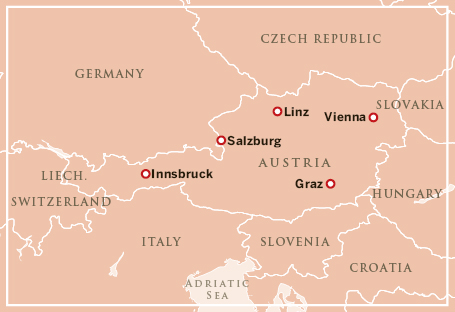
It’s not just Austria’s hills that are alive with the sound of music – the country’s capital is the world centre for classical tunes, and the place to meet Mozart, nibble cake in cafes and go to the ball.
ESSENTIAL EXPERIENCES
* Learning about the main man at the Mozarthaus – one of Wolfgang’s former apartments, now a must-see museum.
* Catching a concert in a traditional Viennese coffeehouse – eat gooey torte while a pro plays piano in the corner.
* Listening to music at the Musikverein or State Opera (or both), two of the world’s very best classical venues.
* Walking in Mozart’s footsteps on a tour of his old Vienna haunts.
* Being overwhelmed by art at the formidable Kunsthistorisches Museum.
* Hearing a freebie – from organ oratories to the annual open-air Vienna Philharmonic concert in the Schönbrunn Palace gardens in June.
Mozart is everywhere in Vienna. Yes, in the spiritual sense: his notes float on the breeze, his 18th-century footsteps seem to waltz on the well-heeled pavements. But he is also quite literally everywhere: in fact, you’ve just banged into him on the platz outside Stephansdom. So busy were you, gazing up at the Gothic cathedral’s zigzag-tiled roof and latticework spire, that you bowled headlong into the man in wig and tights. Before you can apologise, he tries to sell you two tickets to tonight’s Requiem.
Wolfgang lookalikes lurk all over Vienna’s Innere Stadt – the old Imperial city – eager to tout their concerts. Ignore them. Vienna is the undisputed music capital of the world, but these offerings are the tourist tip of the iceberg – they do no justice to a city that’s nurtured not only Mozart but Schubert, Johann Strauss (I and II), Haydn, Mahler and many, many more. This is the city of the Vienna State Opera, which puts on 50 different performances a year. It’s the city of the Musikverein, the 19th-century Neoclassial music hall, home to the esteemed Vienna Philharmonic and reputed to have some of the world’s best acoustics. Then there’s the art-nouveau Konzerthaus, the eclectic Volksoper, the recently revamped Theater an der Wien and the Marionettentheater at Schönbrunn Palace, which sees puppets performing The Magic Flute.
Music isn’t limited to traditional venues either. Vienna is a city of fine coffee-houses and many provide their patrons with live performances. Hear the ivories being tinkled at Café Schwarzenberg, the oldest cafe on the Ringstrasse, which has been serving since 1861. Or order a Mozart-torte at Café Landtmann, where piano recitals have been enjoyed by everyone from Mahler to Paul McCartney. Simply, there’s no city more melodic – or, arguably, more elegant – than Vienna, whether you have the budget of a Habsburgian prince or a struggling artist.
LOCATION AUSTRIA | BEST TIME OF YEAR YEAR-ROUND; WINTER FOR BALLS | IDEAL TIME COMMITMENT THREE TO FOUR DAYS | ESSENTIAL TIP HEAD TO THE HOFBURG CHAPEL ON SUNDAYS (9AM, SEPTEMBER TO JUNE) TO HEAR THE VIENNA BOYS CHOIR FOR FREE | BUDGET $–$$$ | PACK SOMETHING SMART, SO YOU CAN DRESS THE PART FOR A GRAND MUSIC HALL

Let’s dance: the Vienna Opera Ball is a highlight of the city’s winter season and takes place in the State Opera House.
SEAN GALLUP/STAFF | GETTY IMAGES ©
THE VIENNESE WHIRL
If Rio owns the samba then Vienna owns the waltz. And as Rio marks Carnaval with bootie-shaking parades, when Vienna celebrates, it does so with grand balls – indeed, the city hosts around 450 of them, January to March. The season kicks off in sumptuous style with the Imperial Palace’s Grand Bal on New Year’s Eve. Anyone can buy a ticket, but you need a fancy outfit – tux or ballgown – and you need to be able to dance. Take a lesson, even if you’ve waltzed before: the Viennese variety is breathtakingly fast. Elmayer’s Studio offers drop-in tuition sessions for tourists.

Awesome opera.
AFP STRINGER | GETTY IMAGES ©
MOZART: A 60-SECOND GUIDE
Wolfgang Amadeus Mozart was born in Salzburg in 1756. He displayed huge talent almost immediately: at age four he could play piano; at five he was composing; at six he performed before royalty. From 1762 his family made several cross-continent concert tours. Following an unhappy stint as a court musician in Salzburg, Mozart moved to Vienna in 1781. It was his most brilliant and prolific period (in 1788 he wrote three symphonies in ten weeks), though his earnings were swallowed by his lavish lifestyle. In 1791 – aged just 35, but having composed 600-odd works – he died; the cause of his death remains a mystery.
■ The Perfect Getaway
The most harmonious Viennese getaway requires planning before you leave home. Big concerts sell out, so book in advance online. That said, don’t fret if you’ve left it late – there’s a ticket office offering 20% discounts on same-day performances near the State Opera House. Another option is joining the Opera House’s ‘standing tickets’ queue at 6pm, to secure seatless entry for a few euros.
On your first day, get orientated. The Innere Stadt, the historic centre within the Ringstrasse (the city’s main boulevard), is easily walkable. Starting at Stephansplatz, by the cathedral in which Mozart was married, embark on a Wolfgang walking tour, via the Mozarthaus Museum, Michaelerkirche (where Mozart’s Requiem was first played) and his statue in Burggarten. The apartment in which Mozart died was in what is now the Steffl department store and there are great views from the seventh floor. It was in the Hall of Mirrors at Schönbrunn Palace that Mozart (then six years old) first played for the Empress. This Baroque complex, reached on U-Bahn line 4, is a good afternoon option; set in French-style gardens and full of Habsburgian bling; it hosts regular concerts.
Come evening, you must find some music. In April to June and September, live opera is shown on a huge screen in Herbert-von-Karajan-Platz. During July and August, when most concert halls take a break, the Summer of Music Festival fills the void. If you didn’t get into the Opera House, take a tour the next day. Then commune with Strauss’s Blue Danube and hire a rowing boat. Or laze on Danube Island, which in June hosts the free Donauinselfest, a three-day celebration of pop, rock, soul, jazz and more. Whatever would Mozart make of that…?
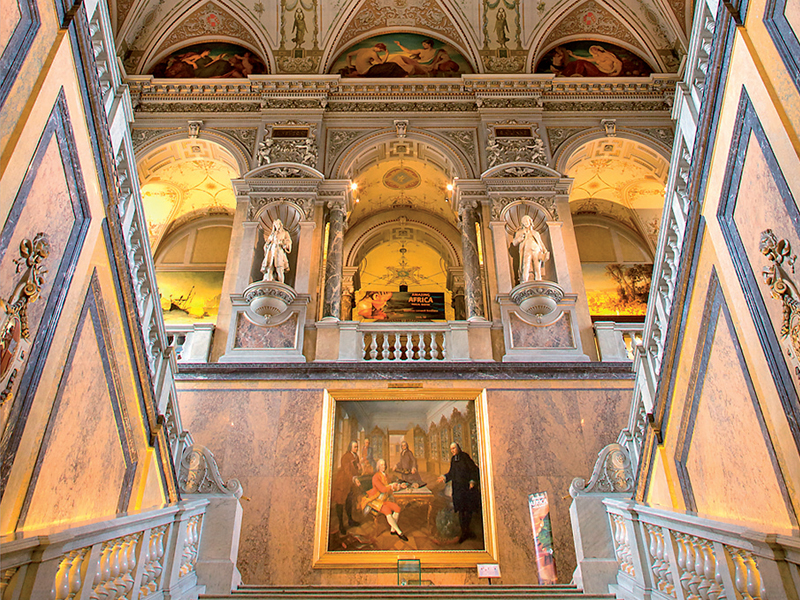
Admire the art in Vienna’s Natural History Museum.
SYLVAIN SONNET | GETTY IMAGES ©
■ Plan It
Vienna-Schwechat Airport is 18km southeast of the city. The City Airport Train (CAT) takes minutes to reach the centre; you can also take trainline S7 or an airport express bus. The Vienna tourism website has a wealth of information; from here you can download walking tours and find links to the main music venues. Tickets for the Vienna Philharmonic New Year Concert are drawn by lot; enter the ballot in January on the orchestra’s website.

Opera aside: Vienna has a cutting-edge contemporary music scene.
LONELY PLANET | GETTY IMAGES ©
■ Detour
After your fill of music, head for the hills. Vienna is the world’s largest wine-growing city, with 7 sq km of vineyards nestled in its immediate vicinity. Take the bus from the centre to Kahlenberg, just north, and you’re soon ambling past tidy lines of vines, the metropolis visible below. Better still, sample the fruits of this labour at the various heurigen – wine taverns where the current vintage is served cheap and on tap. The stove will likely be cooking a meaty speciality and the Gemütlichkeit (that Teutonic brand of cosiness) will be in abundance.
DECKCHAIR
* Mozart: A Life in Letters (Wolfgang Mozart) This compilation of the composer’s correspondence offers a window into his life.
* The Third Man (1949) Classic film noir written by Graham Greene, staring Orson Welles and set in atmospheric post-war Vienna.
* The Mozart Conspiracy (Scott Mariani) Da Vinci Code-ish thriller, set partly in Vienna, in which a letter by Wolfgang may be the key to unlocking a murderous mystery…
* Last Waltz in Vienna: The Destruction of a Family 1842–1942 (George Clare) Heartbreaking account of Jewish life under the Nazis.
* A Time of Gifts (Patrick Leigh Fermor) Superlative travelogue, recounting the author’s 1930s walk along the Danube.
* Amadeus (1984) This lavish Oscar-winner mixes Mozart fact and fiction to dazzling effect.
LIVE LA DOLCE VITA IN WALES
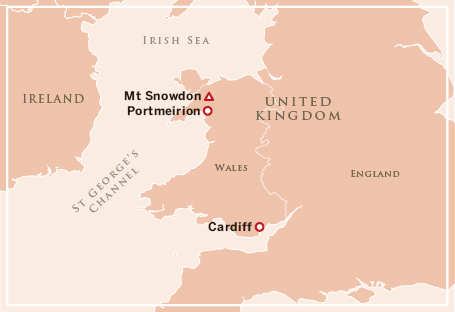
Part Italian Riviera, part sci-fi TV set, a whole lot bonkers – the coastal resort of Portmeirion, an architectural anomaly sitting beneath some of the nation’s highest mountains, is Wales at its most wonderfully weird.
ESSENTIAL EXPERIENCES
* Riding the hill-slicing steam locos of the Ffestiniog Railway to Minffordd, from where Portmeirion is a 1.6km walk.
* Examining the village square’s Bristol Colonnade to locate the Clough Williams-Ellis gargoyle.
* Drinking a cappuccino on the cafe terrace where Number Six drank his morning coffees and feeling truly Prisoner-cum-Italian.
* Being pampered with a deep-sea-diving aroma massage at Battery Square’s Mermaid Spa, the only spa in Snowdonia.
* Promenading along the beach before heading up to the Grotto to watch the sun set over the Dwyryd Estuary.
* Visiting Portmeirion’s Rob Piercy Gallery to admire the works of the local artist.
Are you dreaming? You thought you were on the west coast of Wales. But it seems – from the fountain tinkling in the Piazza, the macho statue of Hercules, the pastel-toned classical architecture and campanile – that you have just walked into Italy. You are discombobulated to say the least, a feeling intensified by the disproportionate number of people walking around in polo-neck pullovers and white-trimmed blazers. What the devil is this place? And what is going on?
To answer that you must delve into the mind of Bertram Clough Williams-Ellis, the mastermind behind the surreal resort of Portmeirion. An architect with a passion for preservation, Clough Williams-Ellis (1883–1978) bought the peninsula-perched site in 1925 for less than £5,000 (about £210,000 in today’s money). It was a rundown wilderness – but not for long. Combining his admiration for the Italian Riviera with a belief that well-planned development could enhance rather than destroy its surroundings, he set about creating something unique. The result of this singular vision is a beautifully bizarre bricolage of Arts and Crafts architecture, Palladian fancy and clever recycling – Clough Williams-Ellis salvaged bits and pieces marked for demolition elsewhere, calling Portmeirion a ‘home for fallen buildings’. To add to the fairytale, all this eccentricity is tucked between forested hills and the peaceful estuary of the River Dwyryd.
But what about those people in polo-necks? Ah, yes, another level of weird. In the 1960s Portmeirion was used as the backdrop for surreal sci-fi/thriller TV series The Prisoner, which saw blazered ex-secret agent Patrick McGoohan (or ‘Number Six’) kept captive in ‘The Village’ – for unknown reasons. All the other inmates were brainwashed; Number Six was the only one with the will to escape, though his attempts were thwarted by enormous white balloons. Odd, yes. But perhaps the perfect match for Portmeirion, where nothing is quite as it seems.
LOCATION COASTAL SNOWDONIA, NORTH WALES | BEST TIME OF YEAR MAY–SEPTEMBER | IDEAL TIME COMMITMENT TWO DAYS | ESSENTIAL TIP STAY OVERNIGHT TO EXPERIENCE PORTMEIRION AFTER HOURS (AND GET FREE ENTRY) | BUDGET $$ | PACK BLACK POLO-NECK PULLOVER AND WHITE-TRIMMED BLAZER

Pretty in pink: Portmeirion’s pastel hues brighten a Welsh day.
ALESSANDRA ALBANESE | CORBIS ©
SNOWDONIA BY STEAM
The narrow-gauge Ffestiniog Railway runs for 21.7km from Blaenau Ffestiniog to Porthmadog; the Minffordd stop is a short stroll from Portmeirion. The railway existed long before the resort: it opened in the 1830s as a gravity-and-horse-pulled service to transport slate from quarries to the coast. In 1863 steam locomotives arrived; a year later came the first passenger cars, and tourists flocked to ride through the steep, spectacular scenery. And they still do – though the line had closed by 1946, passionate locals rebuilt the service and reopened it in 1982. Now steam-powered, heritage Pullman coaches slice though Snowdonia once more.
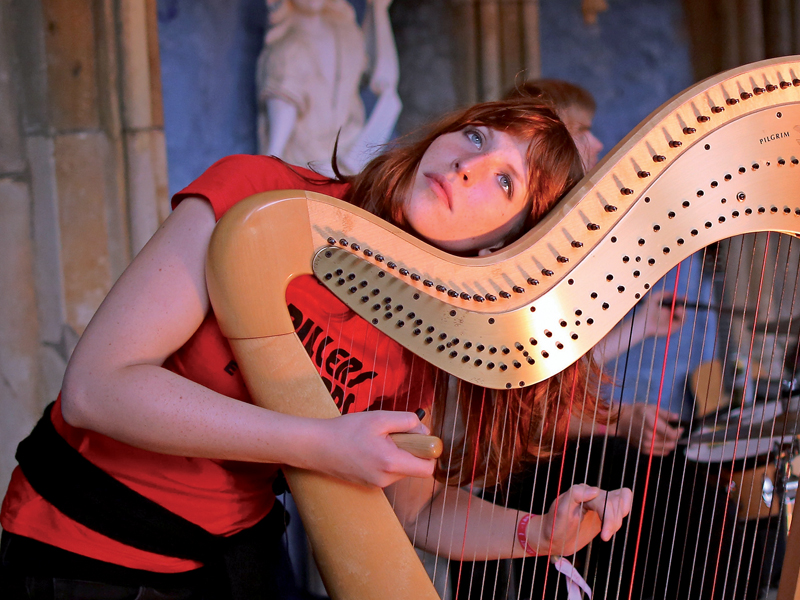
Mali Llewellyn tunes her harp at the festival.
CHRISTOPHER FURLONG/STAFF | GETTY IMAGES ©
UNIQUE PLACE, UNIQUE PARTY
Poetry in the Piazza, rock on the Estuary Stage, big gigs on Stage No.6, intimate sets in the Jacobean Town Hall… According to its organisers, Portmeirion’s Festival No.6 (named, of course, after Patrick McGoohan’s Prisoner) is a gathering unlike any other, in a place unlike any other. It is ‘a scene but not a herd’, encouraging revellers to briefly put reality on hold. Launched in 2012, Festival No.6 takes over the resort for three days in September, packing the Italianate village with headline bands, up-and-coming acts, authors, performance artists, comics, storytellers, fire-twirlers and much more.
■ The Perfect Getaway
The first episode of The Prisoner was called ‘The Arrival’ and saw Number Six waking up in his weird new world. Appropriately, on arriving in the village yourself – via two gatehouse arches – Six’s cottage on Battery Square is one of the first buildings you find. It’s now The Prisoner Shop, selling memorabilia. There’s a cafe on the square, too – have a cappuccino to seal the Italian feel.
Next, explore the rest of the resort. Stroll down the cobbled path to the village green. Look closely at the Colonnade – this 18th-century edifice, rebuilt brick by brick after being salvaged from Bristol, has a more modern addition: a Clough Williams-Ellis gargoyle. Admire the pool and the Gloriette – it was from its balcony that Number Six proclaimed: ‘I am not a number – I am a free man!’ Carrying on through the village, you reach the quayside, where a trail leads along the beach. Further paths lead between a folly lighthouse, exotic trees and a dog cemetery; there are also ruins of the castle that stood here centuries before.
For full immersion, stay at the Hotel Portmeirion, which has hosted luminaries such as HG Wells and George Harrison; the building dates back to 1850 but has been extended and Cloughified now. Eat at the restaurant, which has windows overlooking the water. Best of all, overnighting means you can explore after the daytrippers have left. Rise early the next morning and head up to the Grotto for the best estuary view. Then do what Number Six never could: escape along the beach. Opened in May 2012, the Wales Coast Path (which skirts the country’s seaboard) passes by here. Pick it up heading west and you’ll reach Porthmadog, from where Criccieth Castle is 10km further on.
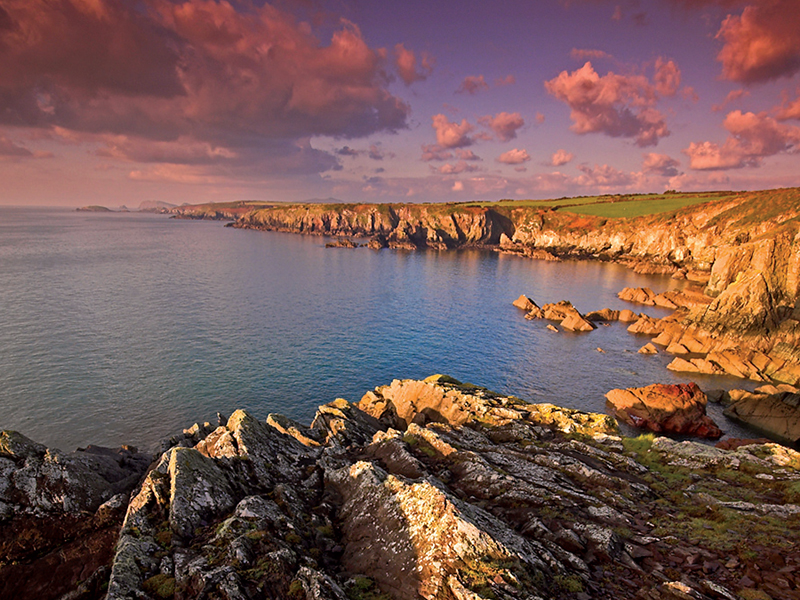
From sea to sky: explore the coast and the mountains of Snowdonia National Park.
ALAN COPSON | CORBIS ©
■ Plan It
Portmeirion is 3km south of Porthmadog, sign-posted from the A487 road at Minffordd. A bus service runs from Porthmadog, March to October. The nearest main train stations are Llandudno Junction and Bangor. From Llandudno Junction, connect to Blaenau Ffestiniog along the Conwy Valley line, then ride the Ffestiniog Railway to Minffordd; there is a footpath to the village. Portmeirion is open every day except Christmas. The resort has two hotels and 17 cottages.
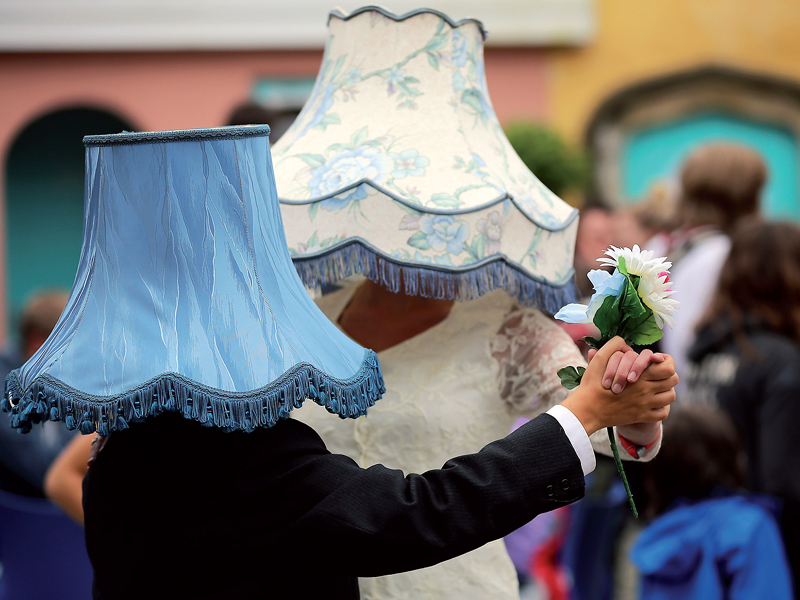
Dancers light up Portmeirion’s quirky Number Six Festival.
CHRISTOPHER FURLONG | GETTY IMAGES ©
■ Detour
Being so close to Mt Snowdon, Wales’s biggest mountain, it would seem rude not to head up it. Ride the newly reopened West Highland Railway (a characterful narrow-gauge line) from Porthmadog to remote Rhyd Ddu station; from here, a gentle trail leads up to the 1085m summit. It’s 12km there and back, and takes around six hours. Alternatively, if you’re feeling more laidback-Italian than hardy-Welsh, make your way to Llanberis and take the Snowdon Mountain Railway to the top.
DECKCHAIR
* Portmeirion (Jan Morris et al) Published in 2006 to mark the 80th anniversary, this resort biography is lavishly illustrated with rare photos and drawings.
* Blithe Spirit (Noel Coward) The playwright penned this comedy in just five days during a stay at Portmeirion.
* Fear in the Sunlight (Nicola Upson) Detective fiction featuring Alfred Hitchcock and set in Portmeirion.
* The Prisoner (1967–68) Bonkers sci-fi/thriller TV series following a former secret agent being held captive in a mysterious coastal resort.
* The Inn of the Sixth Happiness (1958) Snowdonia stands in for China in this Ingrid Bergman movie; the giant gold Buddha statue used in the film now stands just off Portmeirion’s piazza.
* Portmeirion Pottery (Steven Jenkins) Insight into the ceramic craftwork of Susan Williams-Ellis.
FEAST ON ART IN HOBART
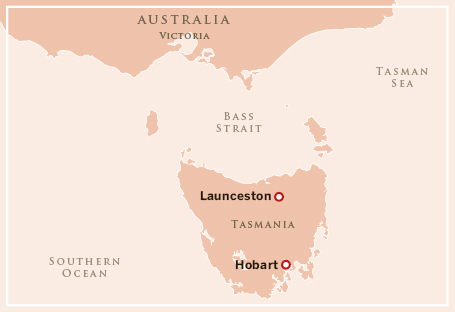
Escape to the ends of the earth for one of the world’s most remote and remarkable art experiences. Tasmania’s capital – next stop, Antarctica – is the beautiful setting for a landmark museum that has transformed the city.
ESSENTIAL EXPERIENCES
* Arriving at MONA on the gallery’s motorboat to absorb Hobart’s wonderful natural setting.
* Spending a Saturday morning at the craft and food market in Salamanca Place before devouring freshly fried seafood and chips on Constitution Dock for lunch.
* Eating at Garagistes, a great no-reservations restaurant. Wait at Sidecar, a tiny bar nearby.
* Hiring a mountain bike and conquering the North–South Track down Mt Wellington.
* Tasting Tasmanian pinot noir at the Frogmore Creek cellar door, 15 minutes from the city.
* Visiting the newly revamped Tasmanian Museum and Art Gallery.
* Feasting on art, music and performance at MONA FOMA, the citywide summer festival.
A pod of dolphins, ducking and diving in the bow wave, escorts your sleek motorboat from Hobart’s waterfront along the Derwent River. Your destination is the Museum of Old and New Art (MONA), a privately owned gallery that opened on the outskirts of the Tasmanian capital in 2011. After disembarking, you take the glass-walled elevator into MONA’s depths where, as you arrive at the base of a three-storey chasm, your first sight is of a bar, complete with a neatly dressed bartender. Your next is of New Zealand artist Julia deVille’s Cinerarium, complete with a neatly stuffed raven watching over an urn of human ashes.
Not long ago the idea of contemplating mortality in a subterranean gallery in Hobart would have been met with incredulous laughter. Hobart, on the same latitude as Patagonia, has long been the sort of place where outdoorsy types mountain bike in the morning, kayak in the afternoon, and wind up having a Cascade or two, the city’s own brew. Logging trucks still rumble through the business district, a clue to the island state’s controversial source of income. But these days, Australia’s poorest state prompts fewer jokes and more envious glances among mainlanders. For Hobart, at the southern tip of Tasmania is transformed.
The catalyst arrived in the shape of a millionaire gambler. David Walsh is the mathematically gifted son of a single mother from Glenorchy, Hobart’s hardscrabble suburb. The art-loving entrepreneur spent his earnings on building an A$80-million museum to house his A$100-million collection. Walsh’s curators describe him as omnivorous: Neolithic arrowheads and Roman, Greek and Egyptian antiquities are arranged beside provocative modern art and key pieces by Australian artists Brett Whiteley and Sidney Nolan. The result is the southern hemisphere’s most exciting art experience.
LOCATION TASMANIA, AUSTRALIA | BEST TIME OF YEAR NOVEMBER TO APRIL | IDEAL TIME COMMITMENT A WEEKEND | ESSENTIAL TIP HAVE A GLASS OF MOORILLA’S WINE OR A MOO BREW BEER AFTER THE ART | BUDGET $$ | PACK AN OPEN MIND
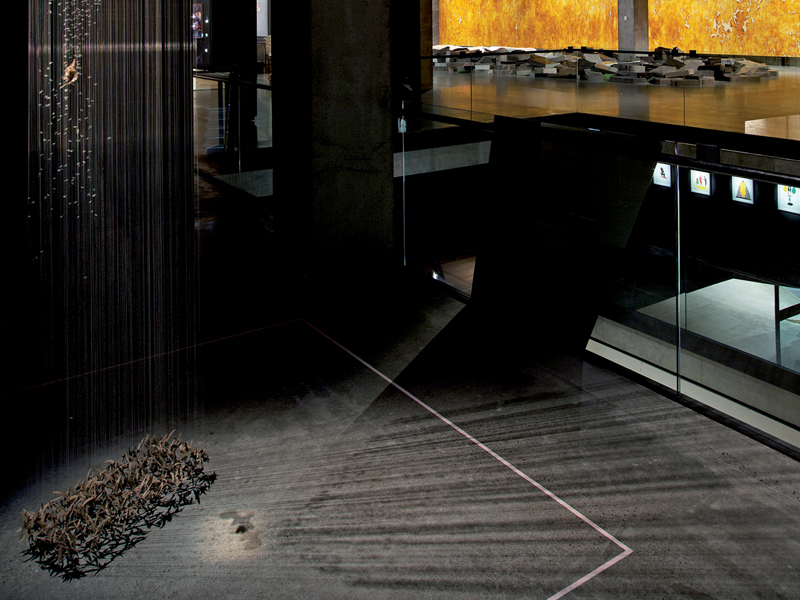
Tracing Time, an installation by Clare Morgan featuring dandelion seeds, leaves and a taxidermied wren; in the background, Wall of Film by Michel Blazy.
MONA/RÉMI CHAUVIN | COURTESY MONA MUSEUM OF OLD AND NEW ART ©
GAMBLING MAN
David Walsh, MONA’s founder, made his millions figuring out formulas for betting successfully on racehorses in the 1980s and ’90s. In 1995 he paid A$2.5 million for Moorilla, a peninsula of land with a vineyard between Hobart and Glenorchy, later adding a boutique winery, a brewery and accommodation. Ten years later Walsh began to construct the Museum of Old and New Art. The design, by Australian architect Nonda Katsalidis, was typically contrarian, building down not up: some 60,000 tonnes of earth were removed and engineers cut through 3km of rock. An elevator sinks into a sandstone-lined shaft; visitors begin at the bottom and make their way up three levels to Tasmania’s blinding sunlight.

David Walsh’s fortress of art.
MONA/RÉMI CHAUVIN | COURTESY MONA MUSEUM OF OLD AND NEW ART ©
SYMPATHY FOR THE DEVIL
The Tasman Peninsula curls towards Hobart from the south. At its tip is Port Arthur, the best-preserved example of a British convict settlement in Australia. But another important act of preservation is taking place on the Arthur Highway at the Tasmanian Devil Conservation Park. Here, the island’s iconic marsupial – ferocious but elusive – is being protected from a virulent facial cancer that has been plaguing wild populations. The park, an hour from Hobart, rescues and breeds devils as the race to find a cure continues. Befitting their voracious image, the devils are fed six times daily. A piece of devil trivia: female devils give birth to around 15 young but can only suckle four. Clearly, it’s a hard-knock life if you’re born a Tassie devil.
■ The Perfect Getaway
Start the day at the Pigeon Hole cafe and bakery, on a hill overlooking West Hobart. The former butcher’s shop, fitted out with vintage furniture, is where MONA’s architects and Hobart’s off-duty chefs grab a coffee and something to eat from a simple menu. Then take the boat (or bus, or bicycle) to MONA. Walsh describes his project as a ‘subversive adult Disneyland’. Rather than a thread to follow through his labyrinth, visitors are handed an iPod loaded with exhibit details, idiosyncratic commentary and the option to ‘love’ or ‘hate’ pieces. Digest the day’s sights (be warned: some of MONA’s content can provoke forthright debate) over a glass of chilled riesling at Moorilla, Walsh’s on-site winery.
The island, says Delia Nicholls, MONA’s curator, has always been regarded by the rest of the country as a ‘beautiful backwater’ – but is now enjoying new-found cultural cachet, for which MONA is not solely responsible. The Tasmanian Museum and Art Gallery, which fascinated Walsh when he was a boy, completed a major redevelopment in 2012; the grand 19th-century waterfront building now has an impressive contemporary entrance and foyer. Go in to get to grips with the island’s natural and cultural heritage.
After a day doing Hobart’s museums, drop into Garagistes, a stripped-out, one-time car workshop on the edge of the CBD, for a glass of wine. Inside, all is cool, dark and airy. Trestle tables are lined up perpendicular to an open kitchen, from where chef Luke Burgess, formerly of Noma in Copenhagen, sends out platters such as veal sweetbreads spiked with sour cherry, and buckwheat, lettuce hearts and nasturtium leaves, each designed for sharing.
It’s quite a jump from pulp mills and half-hewn old-growth forests to state-of-the-art museums and boutique bakeries, but Tasmania is mid-leap.

Luke Burgess’s curing room at Garagistes.
LUKE BURGESS | COURTESY OF GARAGISTES ©
■ Plan It
Most international flights to Hobart arrive via Melbourne or Sydney. Reserve a couple of nights at the Henry Jones Art Hotel, a former warehouse on the harbourside, or the Islington Hotel in South Hobart, both of which have their own art collections on show (spot work by Matisse and Hockney at the Islington). Boat trips to MONA can be booked at a kiosk on the harbour, where you can also hire a bicycle to ride out to the gallery.
■ Detour
Hobart hasn’t shed its adventurous side, and the opportunities for cycling, kayaking and hiking within the city’s boundaries are better than ever. In 2011, a 10km purpose-built track for mountain bikers opened on the flanks of Mt Wellington. The North–South Track descends to Glenorchy Mountain Bike Park; operators such as Vertigo MTB offer rental bikes and shuttle services back to the city. On the waterfront, Freycinet Adventures takes first-time kayakers on tours of Hobart’s harbour or more-experienced kayakers on multiday explorations of the spectacular coastline. Hobart’s natural setting – fringed by hills, forest and some of the clearest water in the world – is as uplifting as any artwork.
DECKCHAIR
* In Tasmania (Nicholas Shakespeare) The biographer of Bruce Chatwin takes some time out in Tassie for reflection and encounters some long-lost family members.
* The Fatal Shore (Robert Hughes) As a feat of research, it’s unparalleled in Australian literature. As an account of Australia’s colonial origins, it’s gripping. Tasmania has a prominent place.
* Death of a River Guide (Richard Flanagan) The debut of Tasmania’s star author. Flanagan went on to win awards with his third novel, Gould’s Book of Fish, and is one of the island’s most vocal protectors.
* The Hunter (2011) Willem Dafoe stars in this thriller based on a hunt for the last Tasmanian tiger.
* Monanism (David Walsh) An occasionally confronting collection of the museum’s pieces and musings by the man himself.
RÉUNION: A MUSICAL TREASURE ISLAND
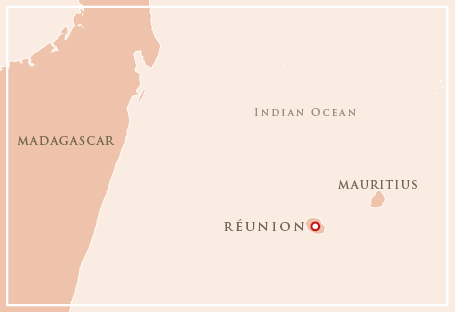
For people who love tropical islands but find beach holidays boring, Réunion is the place to head. The Indian Ocean island is home to a hugely exciting music scene and, for those who like a challenge, the world’s most active volcano to climb.
ESSENTIAL EXPERIENCES
* Watching Christine Salem, the Soul Queen of Réunion, or Danyel Waro, the godfather of maloya, in concert.
* Climbing the active volcano Piton de la Fournaise and marvelling at its lunar landscape.
* Falling on your knees in awe at Le Maïdo, one of the most impressive viewpoints in Réunion and a superb two-wheel destination.
* Going heritage-hunting among the stunning Creole buildings of Hell-Bourg, a beautiful village nestled in the Cirque de Salazie mountains.
* Driving around le sud sauvauge (the wild south), an exciting day trip that provides lush, tropical scenery, wild beaches, lava fields and insights into the island’s large Indian community.
In a shanty restaurant next to the beach, youths are beating funky rhythms on what appear to be pieces of scrap metal. Women dance a sexy chicken strut while those watching salute with beer bottles and offer shouts of joy. Is this Nigeria? Haiti? Or, possibly, Salvador in Brazil? Matter of fact, this is France. To be specific, Réunion, a volcanic island in the Indian Ocean that is an ‘overseas department of France’. Thus you pay with euros, get served croissants for breakfast and, even in the tropical heat, often experience a certain chic Gallic shrug.
Réunion rarely attracts international attention. The occasions for which the island, just south of Mauritius, gets noticed tend to be when Piton de la Fournaise, Réunion’s very active volcano, blows its top. Otherwise Réunion is viewed as an exotic French colony (true) or, for the most part, simply overlooked. Yet anyone who has had the good fortune to encounter Réunion’s vernacular music forms (maloya and sega) is aware that an exciting music scene exists here.
Where sega is light and melodic – the island’s pop music – maloya, a music sung in Creole patois and reliant almost entirely on home-made percussion instruments and voice, is Réunion’s equivalent of roots reggae. For aficionados of ‘world’ music Réunion is a treasure island. Musical tourists should try to attend the Sakifo Musik Festival: this celebration of Indian Ocean music – alongside Réunion artists there are performers from neighbouring islands Mauritius and Madagascar; acts from the French mainland add international flavour while keeping the tropical vibe – takes place in St-Pierre, a Creole town on the island’s southwest coast. Stages are built along the beachfront, so the festival presents a truly lovely way to hear live music. That the temperature is balmy, the sea delicious, the food (fresh fish and spicy stews) yummy and the locals attractive all suggests that there are few finer places to experience music than at Sakifo.
LOCATION RÉUNION, THE INDIAN OCEAN | BEST TIME OF YEAR MAY TO OCTOBER; THE SAKIFO MUSIK FESTIVAL TAKES PLACE IN EARLY JUNE | IDEAL TIME COMMITMENT ONE WEEK | ESSENTIAL TIP TAKE GOOD WALKING BOOTS: RÉUNION IS STEEP! | BUDGET $$ | PACK SUNSCREEN, HAT AND BEACH GEAR

A street musician plays during a festival on Réunion; note the island’s French influences.
DU BOISBERRANGER JEAN / HEMIS.FR | ALAMY ©
DANYEL WARO
The godfather of maloya, Danyel Waro has been noted for his talent since the late 1970s; but for a long time he refused to record or venture beyond Réunion: a veteran activist, he distrusts the music industry. Waro has a remarkably expressive voice and his percussive music is bluesy, full of raw melody and quite beautiful. Waro is Réunion’s most famous citizen and, in concert, a musician as compelling as Joe Strummer or Woody Guthrie. His concerts are exciting, celebratory affairs, while his albums are excellent – Aou Amwin and Bwarouz have both been distributed internationally.

The volcanic amphitheatre of the Cirque de Mafate.
GGERLAND | GETTY IMAGES ©
PITON DE LA FOURNAISE
Réunion’s most famous natural attraction, Piton de la Fournaise is not a dormant monster but an active geological wonder that erupts with great regularity. If it’s not exploding, it is possible to trek right up to the smoking crater. This five-hour trek through lava fields and up the volcano’s loose-rock sides demands a certain level of fitness, good walking boots, a hat, sunscreen and water. Climbing the volcano you may feel this is your last-ever trek – it is not a casual stroll – but once you get to the summit and look down into the smoking crater and then across to the luminescent Indian Ocean all your aches will fade.
■ A Perfect Getaway
Sakifo festival is only once a year, but visitors to Réunion at other times need not worry: music is a major part of Réunion culture and you’ll find it all across the island. Free weekend concerts often take place in towns and villages. The raison d’être behind Réunion’s music scene is its isolation – for centuries the French government treated the island as a big sugar and vanilla plantation – and a Creole culture that blends African, European, Chinese and Indian influences to lend Réunion a unique sound. As do the sugarcane shakers and recycled steel percussion: played by musicians with a sense of rhythm and magnificent voices, this is elemental music-making and as funky as James Brown.
First, hire a car and explore le sud sauvauge (the wild south). Initially, the towns are small and the land lush; the coast is black rock and black sand. Then the landscape becomes a vast lunar park. Lava from eruptions has poured out from Piton de la Fournaise and flowed to the sea, leaving a long, black scar. With mist hanging in the atmosphere and the sea crashing below, this stretch of Réunion feels eerie, at once prehistoric and futuristic.
Don’t ignore Réunion’s east coast; it offers access to Hell-Bourg – a pretty Creole village – and good walking among extinct volcanoes. Réunion lacks the beaches of neighbouring Mauritius, so St Pierre and other seaside towns have built beaches and artificial lagoons. But it’s best to avoid the resorts as the local musicians are not often found in them. And after a day’s volcano climbing what could be better than a cold beer in a shanty bar where the locals beat out the funkiest rhythm you’ve ever heard while chanting in Creole?
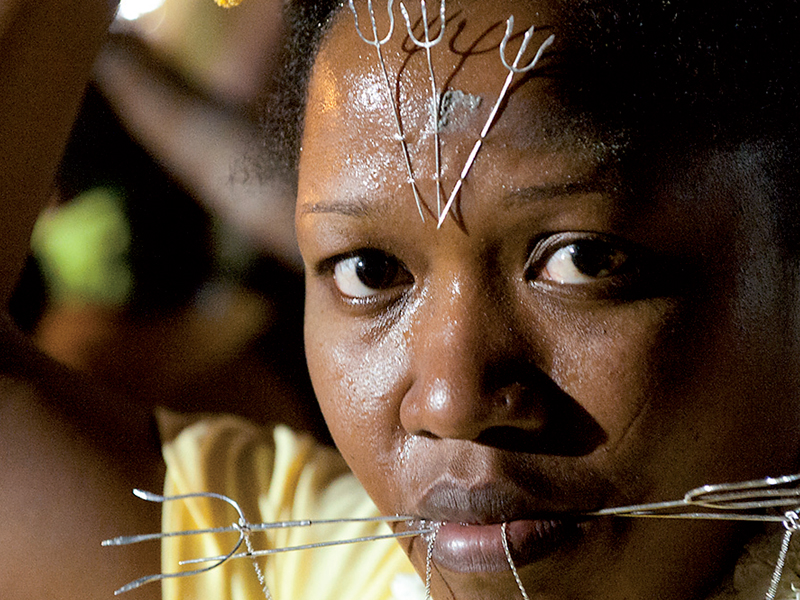
Face-piercing at a Tamil religious ceremony on Réunion.
FRANK HUSTER | GETTY IMAGES ©
■ Plan It
France is the only European country with regular direct flights to Réunion. Car hire is reasonable and there’s a good bus system. Accommodation ranges from backpackers hostels to five-star hotels; homestays abound in rural areas. Sakifo Musik Festival tickets are available at the gate in St-Pierre. No trekking permits are necessary for the volcanoes. Réunion experiences a cool, dry winter from late April to October; the peak tourist season is from late June to early September.

Viewing the volcanic crater at Piton de la Fournaise.
STEFAN KIEFER/IMAGE BROKER | ALAMY ©
■ Detour
You’ve climbed a volcano, now how about mountain-biking down Le Maïdo? This spectacular mountain involves an early-morning start to see the sun rise across the Cirque de Mafate, an undeveloped terrain that suggests a lost world. The Maïdo massif has 150km of marked mountain-biking trails that range from beginner’s routes to those best left to experts. There are several companies offering mountain-bike services, such as group rides and guides for those who don’t wish to cycle alone.
DECKCHAIR
* World Music: The Rough Guide (ed Simon Broughton) Excellent section on Indian Ocean music-making.
* Songlines (UK) The essential-world music magazine is a good read.
* Treasure Island (Robert Louis Stevenson) A timeless yarn.
* Les Chants des Kayanms (Agnès Gueneau) This lyrical tale, evoking the rhythms of maloya (traditional slave music), revolves around a love affair between a local woman and a man from the mainland.
* La Nuit Cyclone (Jean-François Sam-Long) Sam-Long, a novelist and poet who helped relaunch Réunion’s Creole literature in the 1970s, explores in this novel the gulf between whites and blacks in a small village, against a backdrop of black magic and superstition.
* Chasseurs des Noires (Daniel Vaxelaire) An easily accessible historical tale of a slave-hunter’s life-changing encounter with an escaped slave.
FEELING FADO IN LISBON
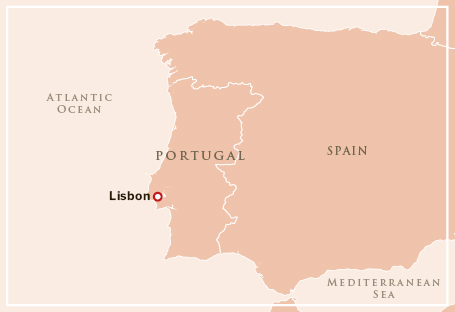
It’s soulful, passionate and melodic. It kicks tango’s ass. Its traditions are Portuguese. And it was recently added to Unesco’s Intangible Cultural Heritage list. This is fado.
ESSENTIAL EXPERIENCES
* Getting lost in the village-like lanes of Alfama, searching for the soul of fado.
* Jumping aboard tram 28 for a teeth-rattling, roller-coaster ride around Alfama and beyond.
* Devouring the famous, delectable custard tarts at Antiga Confeitaria de Belém – and trying to guess the secret ingredient.
* Absorbing the Manueline fantasy of Mosteiro dos Jerónimos in Belém – nothing compares to the moment you walk into the honey-stone cloisters.
* Embarking on a shopping frenzy and taking in the pleasant outdoor cafes and restaurants in elegant Chiado.
* Striding through enchanted forests to above-the-clouds palaces and castles in Sintra.
Hot, passionate and intimate – welcome to the intoxicating world of fado. Where a singer, silhouetted against a velvet backdrop and dim red backlighting, closes her eyes, tilts her head and sways gently. She opens her mouth and deep, wistful notes fill the room. Several people, gathered with friends around tables, know the tunes and their idiosyncrasies. Some click their fingers, others gasp in appreciation as the melody rises and falls. Some sing along, never taking their eyes off the face of the fadista (fado singer), as it contorts into agony, then ecstasy. Song over, applause and cheering fills the room.
A fado performance is integral to any visit to Lisbon, especially in the capital’s historic neighbourhood of Alfama, a labyrinth of cobbled lanes. After midnight, Alfama casts a special spell; follow the musical notes of the mournful ballads that resonate off the stone walls. You’ll soon encounter a fado club, often no more than a crowded room, where male and female singers perform for Lisboêtas who are passionate about fado and its traditions. Fado’s roots are in Lisbon – and along the seafaring coast – where in the 1850s sailors and ruffians sang of life, love, fate and death. Fado’s distinct bluesy tunes and lyrics are linked to the Portuguese word saudade, meaning longing or nostalgic yearning. Portuguese nobility eventually caught on to fado’s charms, and fado performance took off more formally. In the 20th century, a 12-string Portuguese guitar and a classical guitar were added as instrumental accompaniments.
These days, new generations of stars, including Ana Moura, Carminho and Mariza, are adding their own touches to fado – contemporary fusion sounds, Cuban-style jazz and even orchestras. The best way to feel fado is in a Lisbon club. These range from touristy three-tunes-and-a-meal venues to high-quality establishments, popular among locals for their quality of fado and ambience.
LOCATION LISBON, PORTUGAL | BEST TIME OF YEAR YEAR-ROUND | IDEAL TIME COMMITMENT THREE TO FOUR DAYS | ESSENTIAL TIP FADO IS THE DOMAIN OF NIGHT OWLS; HAVE AN AFTERNOON SIESTA TO PREPARE FOR A NIGHT OUT | BUDGET $$ | PACK EXTRA CASH FOR A FADO ALBUM (OR THREE)
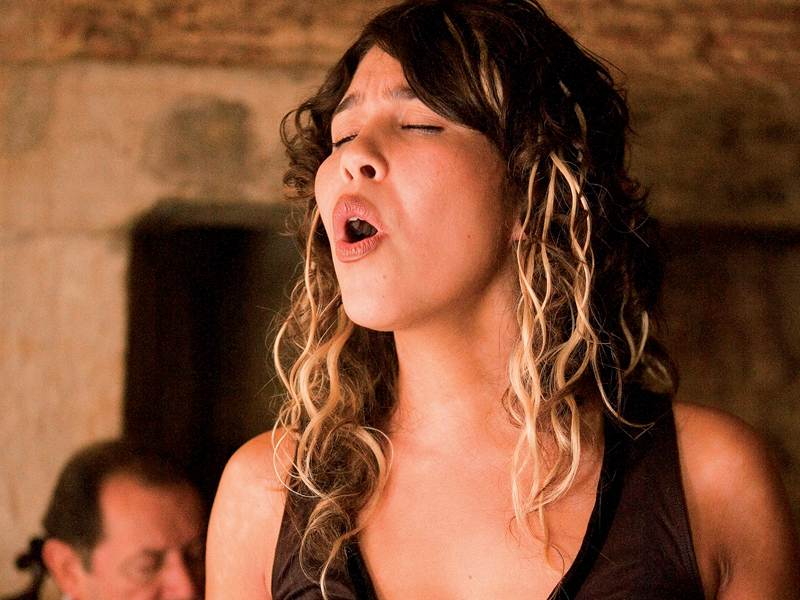
Fado singers touch hearts in the bars and restaurants of Lisbon’s Alfama neighbourhood.
OSO MEDIA | ALAMY ©
THE FADISTAS’ SONG
It’s very hard to define exactly what fado is; ask the locals to explain it and you’ll receive different answers. Even fadistas (fado singers) themselves struggle to define the music and songs. This may be because, as Amália Rodrigues, the Queen of Fado, famously proclaimed, ‘I don’t sing fado. It sings me.’ Ana Moura, one of Portugal’s current fado divas, thinks along the same lines: ‘Fado is difficult to define. It’s something you need to feel. It’s a kind of music where we use the melody and words to express what’s going on in our soul.’ The easiest way of understanding the concept of fado and saudade – melancholic longing – is to listen to it.

Search out boutiques by day and hidden nightspots after dark in the Bairro Alto neighbourhood.
SANDRA RACCANELLO/SIME | 4CORNERS ©
LISBON’S ICONIC VIEWPOINTS
Lisbon is spread across steep hillsides that overlook the Rio Tejo. While puffing up the cobbled streets can be hard work, several steep stairways lead to miradouros (viewpoints) that afford mind-boggling views. The Moorish gateway of Largo das Portas do Sol gives a bird’s-eye vista of Alfama’s jumble of pastel houses and red rooftops. In neighbouring Graça, the pine-fringed Miradouro da Graça is the perfect place for a sundowner and sweeping vistas over central Lisbon, while Miradouro da Senhora do Monte, one of the highest points, offers the best views of the castle on the hill opposite.
■ The Perfect Getaway
You need a few days to get your head around Lisbon, though its magic will hit immediately. A fun way to get your bearings on your first day is to take a rattling ride on tram 28, Lisbon’s vintage trolley car. It offers the ultimate spin around the city’s top sights, from Basílica da Estrela to the backstreets of Baixa (downtown), via the Sé (Cathedral) and Alfama. Then, wander the streets of Baixa – Rua Augusta is delightful. Along here, pop into Museu do Design e da Moda for a superb take on contemporary Lisbon. Follow this with window-shopping and cafe-hopping in well-heeled Chiado, where some of Lisbon’s top designers tout their wares, then tap into your inner-retro in Bairro Alto – an adjacent district peppered with funky boutiques. Finish your explorations by heading east of Alfama to the Museu Nacional do Azulejo (National Tile Museum), a 16th-century convent that exhibits the country’s exquisite blue-and-white azulejos. For your evening meal, head to the pretty Santo António de Alfama.
The next morning, hop on a (modern) tram at Praça da Figueira and head to Belém, a half-hour ride from Baixa. Its must-visit experience is Antiga Confeitaria de Belém, a world-renowned patisserie that is custard-tart nirvana. This will give you energy to tackle the Manueline cloisters of Mosteiro dos Jerónimos, a Unesco World Heritage Site. Enjoy lunch while overlooking the Rio Tejo at À Margem. In the afternoon, head back to Alfama and stroll through the pretty streets. Pop into the fascinating Museu do Fado to prepare yourself for all things fado. As dusk falls and the street lanterns light up, enjoy a drink at the Wine Bar do Castelo. Then follow the soul and sounds of Portugal and head to a fado performance.

The view from Belém Tower, guardian of Lisbon’s harbour.
JOHANNA HUBER/SIME | 4CORNERS ©
■ Plan It
As Portugal’s cultural mecca, Lisbon is a great spot to catch a fado performance (reservations are necessary for some clubs). The city’s tourist office can suggest fado clubs, but in order to tune into the best places, just ask the locals – a follower will know the current hot spots. Most clubs are open year-round. Most international visitors arrive at Lisbon Airport. From here, both buses and metro services run frequently to the city centre. Alfama is a handy (if cramped) base to stay; other centrally located neighbourhoods are as convenient.
■ Detour
For a stimulating experience of a different kind, the must-do day trip has to be Sintra, around 35km west of Lisbon, and accessible by train from the city. Its centre – Sintra-Vila – is Unesco World Heritage–listed for good reason. With lush gardens and forests, rippling mountains and exotic palaces, Sintra resembles a magical fairyland (but genuine – we’re not talking Disneyland). If you’re ‘castled out’, you can visit the modern art museum.
DECKCHAIR
* Fados (2007) Directed by Carlos Saura, this is one of the few movies about fado, depicting the songs, the music and dancing.
* Amália (2008) This biopic, directed by Carlos Coelho da Silva, provides an in-depth look at the life of Amália Rodrigues, the Queen of Fado.
* The History of the Portuguese Fado (Paul Vernon) This book covers the origins, history and meaning of fado.
* Best of Amália Rodrigues (Amália Rodrigues), 100 Canções, Uma Vida (Carlos do Carmo), Desfado (Ana Moura), Fado em mim (Mariza), Alma (Carminho) are all albums that offer a gorgeous introduction to fado.
* Tile Designs from Portugal (Diego Hurtado De Mendoza) This book features the stunning designs and colours of Portuguese azulejos (tiles).
DIVE INTO LITERARY DUBLIN
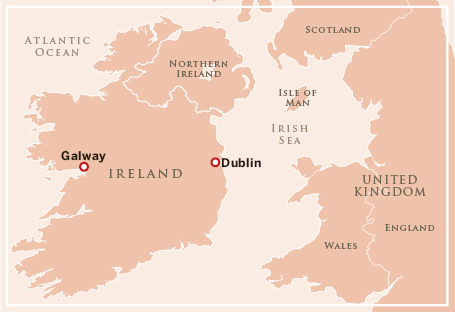
Joyce, Shaw, Wilde, Beckett, Stoker: follow in their footsteps and discover what it is about Dublin – a Unesco City of Literature that claims four Nobel Prize winners for literature – that inspired so many of the world’s greatest writers.
ESSENTIAL EXPERIENCES
* Peering at the beautiful detail of the Book of Kells, one of the oldest tomes in the world.
* Pondering Oscar Wilde’s rise and fall at his memorial in Merrion Square.
* Seeing a new Irish play or a revival of a classic at Ireland’s famous national theatre, the Abbey Theatre.
* Poring over ancient books and other printed wonders from all around the world in the Chester Beatty Library.
* Combining great stories and great pubs on the Dublin Literary Pub Crawl.
* Following in Leopold Bloom’s footsteps by downing a gorgonzola sandwich and a glass of burgundy at Davy Byrne’s.
‘Good puzzle would be cross Dublin without passing a pub,’ ponders Leopold Bloom. It’s not a puzzle that the central character of Ulysses, James Joyce’s famously complex novel, is in danger of solving. At Davy Byrne’s pub on Duke St, Bloom orders a gorgonzola sandwich and a glass of burgundy, which you can still devour there today.
Nearby McDaid’s pulled pints for postwar playwright and novelist Brendan Behan. And one of the city’s oldest pubs, Toner’s, scored a first in 1922 when it hosted the abstemious poet WB Yeats. According to literary legend, Yeats was offered a glass of sherry, drank it, announced ‘Now I have seen a pub,’ and left.
It’s hard to separate writers from pubs in the Irish capital, but they’re not the only places with rich literary connections. The great novelist and playwright George Bernard Shaw spent many hours in the city’s National Gallery during an unhappy childhood, its paintings easing his loneliness. He later left a share of his royalties to the institution, which has since paid for much new art. Like so many of his fellow writers, Shaw took inspiration from the city, and paid back that debt with dazzling creative works.
Dublin has long been a hotbed of writing talent, throwing up such diverse geniuses as Oscar Wilde, Samuel Beckett and Bram Stoker. But why is it so? The city is – to be frank – not one of Europe’s most spectacular to look at. But maybe that’s the key to escaping into Dublin’s literary heart. A rainy city on an island on the western edge of Europe, with a history tinged with tragedy and a rich culture of folklore and storytelling, was destined to turn inwards – to the pubs, the libraries, the galleries, the soul – and thus produce grand stories.
Follow the example of Dublin’s great writers by heading to the nearest pub; with more than a thousand of them you’ll be hard-pressed to solve Bloom’s puzzle. There you can sip a beer, soak up the atmosphere and put pen to paper.
LOCATION DUBLIN, IRELAND | BEST TIME OF YEAR MAY TO OCTOBER | IDEAL TIME COMMITMENT A LONG WEEKEND | ESSENTIAL TIP READ ULYSSES BEFORE YOU ARRIVE | BUDGET $$ | PACK PLENTY OF IRISH LITERATURE AND AN UMBRELLA
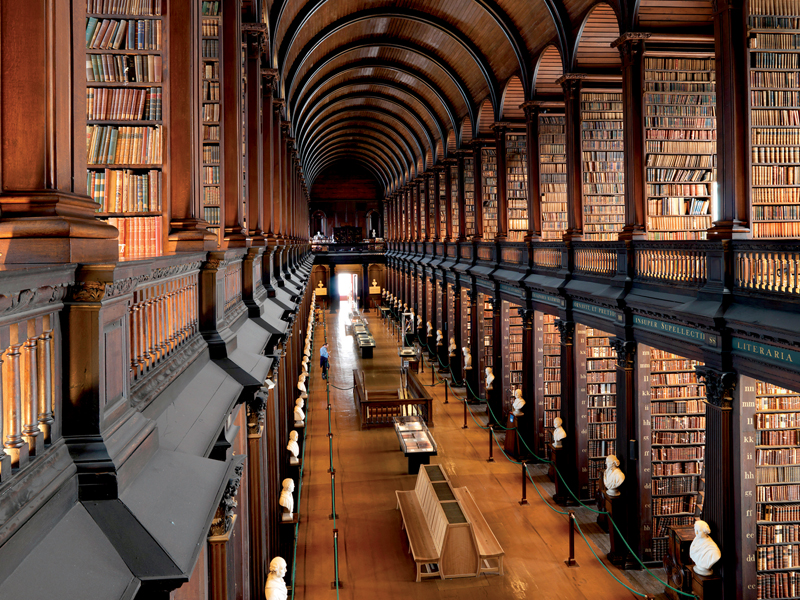
The beauty of books in the Long Room of the Old Library at Trinity College.
CHRIS HILL | CORBIS ©
BRAM STOKER, VAMPIRE WRITER
When it was published in 1897, no one could have guessed that Dracula would make Bram Stoker the most influential horror fiction novelist ever. Born in Dublin in 1847, Stoker had been a sickly child with plenty of time for reading. As an adult he became friends with Oscar Wilde and the actor Henry Irving. But it was possibly from his chance meeting with Hungarian historian and traveller Arminius Vámbéry that Stoker learned of the legend of Vlad the Impaler, aka Dracula. Vámbéry’s reward? As rumour has it, he was immortalised in the novel as Abraham Van Helsing, Dracula’s implacable foe.
■ The Perfect Getaway
Dublin offers many ways of exploring its literary heritage. Start at Trinity College, where the beautifully illustrated, 1200-year-old Book of Kells is the star attraction. Created by Celtic monks, this gospel tome contains vivid illustrations of people, animals and mythical beasts. To see it within its low-light room is a moving experience, and a reminder of the power of images when combined with words.
Also included in admission is the magnificent Long Room, an 18th-century library with oak shelves holding 200,000 books. With its vaulted ceiling and marble busts of writers and philosophers, it’s like something out of Harry Potter.
East of Trinity College, Sweny’s, a former pharmacy mentioned in Ulysses, sells books by Irish writers of all eras. Around the corner in Merrion Square you’ll find a statue of Oscar Wilde lounging on a large rock. Behind St Patrick’s Cathedral is Archbishop Marsh’s Library. This 1701 treasure trove of rare books still has its original carved bookcases and wire ‘cages’, into which scholars were locked while studying valuable works: no chance of nicking a first edition here.
Another must-visit library is the Chester Beatty, in Dublin Castle’s grounds. The collection of an American mining engineer, it contains a vast number of manuscripts, rare books and miniature paintings. Reaching beyond the Western world, the Beatty amassed impressive Islamic works. Seeing such a gathering of the world’s creativity in one place is inspirational, and must have sparked the imagination of more than one Dublin writer. You’ll quickly realise writers in Dublin are a much-valued part of the everyday landscape. Celebrate their stories, and create some of your own, too.

A Dublin bartender delivers pints of Guinness, the city’s stout; it takes a couple of minutes for the head to settle.
OLIVER STREWE | GETTY IMAGES ©
■ Plan It
Dublin is well connected by air to Europe and beyond. Combine a visit with a jaunt to the UK, as flights between the two are frequent and short. There are also ferry connections from Dublin to the UK, and from Ireland’s southern ports to France. The city is small and easy to get around, offering no greater challenge than struggling to be cultural the morning after the night before.
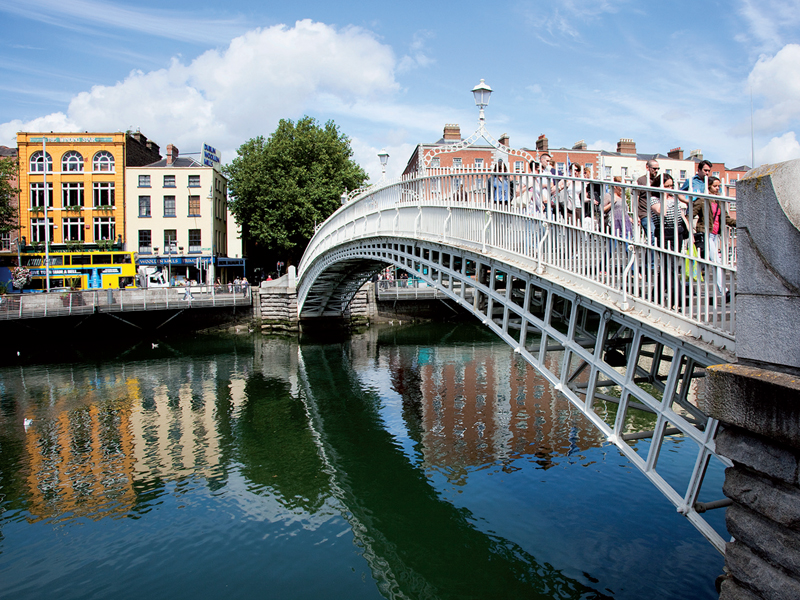
Crossing the River Liffey on Ha’penny Bridge, which dates from 1816.
PETER ZOELLER/DESIGN PICS | CORBIS ©
■ Detour
If it’s music that floats your boat, take a trip across the Emerald Isle to Galway, where pubs ring out to the sound of Celtic ballads and traditional Irish folk songs. This tiny west-coast city, two hours from Dublin by car, is a hotbed of live music venues, most of them brightly painted pubs where locals and visitors, pints of stout in hand, crowd around a band playing traditional Irish instruments such as bodhrán drums and fiddles. The Galway Arts Festival takes place over two weeks every summer; to whet your appetite for Irish music listen to songs by The Dubliners.
DECKCHAIR
* Ulysses (James Joyce) The quintessential ‘difficult book’, this novel’s story takes place across Dublin on a single day.
* Gulliver’s Travels (Jonathan Swift) Dublin’s satirist-in-chief created a world of giants, Lilliputians and sophisticated Houyhnhnms in his 1726 classic, which cuts government and religion down to size.
* The Picture of Dorian Grey (Oscar Wilde) In addition to plays like An Ideal Husband, Wilde wrote this entertaining novella.
* The Deportees (Roddy Doyle) This 2008 work explores the stories of recent immigrants to Dublin.
* The Shelbourne (Elizabeth Bowen) Novel featuring a landmark hotel in Dublin and its interaction with decades of Irish history.
* Dublin Noir: The Celtic Tiger vs the Ugly American (Ken Bruen) A collection of short crime stories set in the city.